- Google Slides Presentation Design
- Pitch Deck Design
- Powerpoint Redesign
- Other Design Services

- Guide & How to's

How to present a research paper in PPT: best practices
A research paper presentation is frequently used at conferences and other events where you have a chance to share the results of your research and receive feedback from colleagues. Although it may appear as simple as summarizing the findings, successful examples of research paper presentations show that there is a little bit more to it.
In this article, we’ll walk you through the basic outline and steps to create a good research paper presentation. We’ll also explain what to include and what not to include in your presentation of research paper and share some of the most effective tips you can use to take your slides to the next level.
Research paper PowerPoint presentation outline
Creating a PowerPoint presentation for a research paper involves organizing and summarizing your key findings, methodology, and conclusions in a way that encourages your audience to interact with your work and share their interest in it with others. Here’s a basic research paper outline PowerPoint you can follow:
1. Title (1 slide)
Typically, your title slide should contain the following information:
- Title of the research paper
- Affiliation or institution
- Date of presentation
2. Introduction (1-3 slides)
On this slide of your presentation, briefly introduce the research topic and its significance and state the research question or objective.
3. Research questions or hypothesis (1 slide)
This slide should emphasize the objectives of your research or present the hypothesis.
4. Literature review (1 slide)
Your literature review has to provide context for your research by summarizing relevant literature. Additionally, it should highlight gaps or areas where your research contributes.
5. Methodology and data collection (1-2 slides)
This slide of your research paper PowerPoint has to explain the research design, methods, and procedures. It must also Include details about participants, materials, and data collection and emphasize special equipment you have used in your work.
6. Results (3-5 slides)
On this slide, you must present the results of your data analysis and discuss any trends, patterns, or significant findings. Moreover, you should use charts, graphs, and tables to illustrate data and highlight something novel in your results (if applicable).
7. Conclusion (1 slide)
Your conclusion slide has to summarize the main findings and their implications, as well as discuss the broader impact of your research. Usually, a single statement is enough.
8. Recommendations (1 slide)
If applicable, provide recommendations for future research or actions on this slide.
9. References (1-2 slides)
The references slide is where you list all the sources cited in your research paper.
10. Acknowledgments (1 slide)
On this presentation slide, acknowledge any individuals, organizations, or funding sources that contributed to your research.
11. Appendix (1 slide)
If applicable, include any supplementary materials, such as additional data or detailed charts, in your appendix slide.
The above outline is just a general guideline, so make sure to adjust it based on your specific research paper and the time allotted for the presentation.
Steps to creating a memorable research paper presentation
Creating a PowerPoint presentation for a research paper involves several critical steps needed to convey your findings and engage your audience effectively, and these steps are as follows:
Step 1. Understand your audience:
- Identify the audience for your presentation.
- Tailor your content and level of detail to match the audience’s background and knowledge.
Step 2. Define your key messages:
- Clearly articulate the main messages or findings of your research.
- Identify the key points you want your audience to remember.
Step 3. Design your research paper PPT presentation:
- Use a clean and professional design that complements your research topic.
- Choose readable fonts, consistent formatting, and a limited color palette.
- Opt for PowerPoint presentation services if slide design is not your strong side.
Step 4. Put content on slides:
- Follow the outline above to structure your presentation effectively; include key sections and topics.
- Organize your content logically, following the flow of your research paper.
Step 5. Final check:
- Proofread your slides for typos, errors, and inconsistencies.
- Ensure all visuals are clear, high-quality, and properly labeled.
Step 6. Save and share:
- Save your presentation and ensure compatibility with the equipment you’ll be using.
- If necessary, share a copy of your presentation with the audience.
By following these steps, you can create a well-organized and visually appealing research paper presentation PowerPoint that effectively conveys your research findings to the audience.
What to include and what not to include in your presentation
In addition to the must-know PowerPoint presentation recommendations, which we’ll cover later in this article, consider the following do’s and don’ts when you’re putting together your research paper presentation:
- Focus on the topic.
- Be brief and to the point.
- Attract the audience’s attention and highlight interesting details.
- Use only relevant visuals (maps, charts, pictures, graphs, etc.).
- Use numbers and bullet points to structure the content.
- Make clear statements regarding the essence and results of your research.
Don’ts:
- Don’t write down the whole outline of your paper and nothing else.
- Don’t put long, full sentences on your slides; split them into smaller ones.
- Don’t use distracting patterns, colors, pictures, and other visuals on your slides; the simpler, the better.
- Don’t use too complicated graphs or charts; only the ones that are easy to understand.
- Now that we’ve discussed the basics, let’s move on to the top tips for making a powerful presentation of your research paper.
8 tips on how to make research paper presentation that achieves its goals
You’ve probably been to a presentation where the presenter reads word for word from their PowerPoint outline. Or where the presentation is cluttered, chaotic, or contains too much data. The simple tips below will help you summarize a 10 to 15-page paper for a 15 to 20-minute talk and succeed, so read on!
Tip #1: Less is more
You want to provide enough information to make your audience want to know more. Including details but not too many and avoiding technical jargon, formulas, and long sentences are always good ways to achieve this.
Tip #2: Be professional
Avoid using too many colors, font changes, distracting backgrounds, animations, etc. Bullet points with a few words to highlight the important information are preferable to lengthy paragraphs. Additionally, include slide numbers on all PowerPoint slides except for the title slide, and make sure it is followed by a table of contents, offering a brief overview of the entire research paper.
Tip #3: Strive for balance
PowerPoint slides have limited space, so use it carefully. Typically, one to two points per slide or 5 lines for 5 words in a sentence are enough to present your ideas.
Tip #4: Use proper fonts and text size
The font you use should be easy to read and consistent throughout the slides. You can go with Arial, Times New Roman, Calibri, or a combination of these three. An ideal text size is 32 points, while a heading size is 44.
Tip #5: Concentrate on the visual side
A PowerPoint presentation is one of the best tools for presenting information visually. Use graphs instead of tables and topic-relevant illustrations instead of walls of text. Keep your visuals as clean and professional as the content of your presentation.
Tip #6: Practice your delivery
Always go through your presentation when you’re done to ensure a smooth and confident delivery and time yourself to stay within the allotted limit.
Tip #7: Get ready for questions
Anticipate potential questions from your audience and prepare thoughtful responses. Also, be ready to engage in discussions about your research.
Tip #8: Don’t be afraid to utilize professional help
If the mere thought of designing a presentation overwhelms you or you’re pressed for time, consider leveraging professional PowerPoint redesign services . A dedicated design team can transform your content or old presentation into effective slides, ensuring your message is communicated clearly and captivates your audience. This way, you can focus on refining your delivery and preparing for the presentation.
Lastly, remember that even experienced presenters get nervous before delivering research paper PowerPoint presentations in front of the audience. You cannot know everything; some things can be beyond your control, which is completely fine. You are at the event not only to share what you know but also to learn from others. So, no matter what, dress appropriately, look straight into the audience’s eyes, try to speak and move naturally, present your information enthusiastically, and have fun!
If you need help with slide design, get in touch with our dedicated design team and let qualified professionals turn your research findings into a visually appealing, polished presentation that leaves a lasting impression on your audience. Our experienced designers specialize in creating engaging layouts, incorporating compelling graphics, and ensuring a cohesive visual narrative that complements content on any subject.
#ezw_tco-2 .ez-toc-widget-container ul.ez-toc-list li.active::before { background-color: #ededed; } Table of contents
- Presenting techniques
- 50 tips on how to improve PowerPoint presentations in 2022-2023 [Updated]
- Keynote VS PowerPoint
- Types of presentations
- Present financial information visually in PowerPoint to drive results

- Design Tips
8 rules of effective presentation

- Business Slides
Employee training and onboarding presentation: why and how

How to structure, design, write, and finally present executive summary presentation?

- Publication Recognition
How to Make a PowerPoint Presentation of Your Research Paper
- 4 minute read
- 121.5K views
Table of Contents
A research paper presentation is often used at conferences and in other settings where you have an opportunity to share your research, and get feedback from your colleagues. Although it may seem as simple as summarizing your research and sharing your knowledge, successful research paper PowerPoint presentation examples show us that there’s a little bit more than that involved.
In this article, we’ll highlight how to make a PowerPoint presentation from a research paper, and what to include (as well as what NOT to include). We’ll also touch on how to present a research paper at a conference.
Purpose of a Research Paper Presentation
The purpose of presenting your paper at a conference or forum is different from the purpose of conducting your research and writing up your paper. In this setting, you want to highlight your work instead of including every detail of your research. Likewise, a presentation is an excellent opportunity to get direct feedback from your colleagues in the field. But, perhaps the main reason for presenting your research is to spark interest in your work, and entice the audience to read your research paper.
So, yes, your presentation should summarize your work, but it needs to do so in a way that encourages your audience to seek out your work, and share their interest in your work with others. It’s not enough just to present your research dryly, to get information out there. More important is to encourage engagement with you, your research, and your work.
Tips for Creating Your Research Paper Presentation
In addition to basic PowerPoint presentation recommendations, which we’ll cover later in this article, think about the following when you’re putting together your research paper presentation:
- Know your audience : First and foremost, who are you presenting to? Students? Experts in your field? Potential funders? Non-experts? The truth is that your audience will probably have a bit of a mix of all of the above. So, make sure you keep that in mind as you prepare your presentation.
Know more about: Discover the Target Audience .
- Your audience is human : In other words, they may be tired, they might be wondering why they’re there, and they will, at some point, be tuning out. So, take steps to help them stay interested in your presentation. You can do that by utilizing effective visuals, summarize your conclusions early, and keep your research easy to understand.
- Running outline : It’s not IF your audience will drift off, or get lost…it’s WHEN. Keep a running outline, either within the presentation or via a handout. Use visual and verbal clues to highlight where you are in the presentation.
- Where does your research fit in? You should know of work related to your research, but you don’t have to cite every example. In addition, keep references in your presentation to the end, or in the handout. Your audience is there to hear about your work.
- Plan B : Anticipate possible questions for your presentation, and prepare slides that answer those specific questions in more detail, but have them at the END of your presentation. You can then jump to them, IF needed.
What Makes a PowerPoint Presentation Effective?
You’ve probably attended a presentation where the presenter reads off of their PowerPoint outline, word for word. Or where the presentation is busy, disorganized, or includes too much information. Here are some simple tips for creating an effective PowerPoint Presentation.
- Less is more: You want to give enough information to make your audience want to read your paper. So include details, but not too many, and avoid too many formulas and technical jargon.
- Clean and professional : Avoid excessive colors, distracting backgrounds, font changes, animations, and too many words. Instead of whole paragraphs, bullet points with just a few words to summarize and highlight are best.
- Know your real-estate : Each slide has a limited amount of space. Use it wisely. Typically one, no more than two points per slide. Balance each slide visually. Utilize illustrations when needed; not extraneously.
- Keep things visual : Remember, a PowerPoint presentation is a powerful tool to present things visually. Use visual graphs over tables and scientific illustrations over long text. Keep your visuals clean and professional, just like any text you include in your presentation.
Know more about our Scientific Illustrations Services .
Another key to an effective presentation is to practice, practice, and then practice some more. When you’re done with your PowerPoint, go through it with friends and colleagues to see if you need to add (or delete excessive) information. Double and triple check for typos and errors. Know the presentation inside and out, so when you’re in front of your audience, you’ll feel confident and comfortable.
How to Present a Research Paper
If your PowerPoint presentation is solid, and you’ve practiced your presentation, that’s half the battle. Follow the basic advice to keep your audience engaged and interested by making eye contact, encouraging questions, and presenting your information with enthusiasm.
We encourage you to read our articles on how to present a scientific journal article and tips on giving good scientific presentations .
Language Editing Plus
Improve the flow and writing of your research paper with Language Editing Plus. This service includes unlimited editing, manuscript formatting for the journal of your choice, reference check and even a customized cover letter. Learn more here , and get started today!

- Manuscript Preparation
Know How to Structure Your PhD Thesis

- Research Process
Systematic Literature Review or Literature Review?
You may also like.

What is a Good H-index?

What is a Corresponding Author?

How to Submit a Paper for Publication in a Journal
Input your search keywords and press Enter.

Princeton Correspondents on Undergraduate Research
How to Make a Successful Research Presentation
Turning a research paper into a visual presentation is difficult; there are pitfalls, and navigating the path to a brief, informative presentation takes time and practice. As a TA for GEO/WRI 201: Methods in Data Analysis & Scientific Writing this past fall, I saw how this process works from an instructor’s standpoint. I’ve presented my own research before, but helping others present theirs taught me a bit more about the process. Here are some tips I learned that may help you with your next research presentation:
More is more
In general, your presentation will always benefit from more practice, more feedback, and more revision. By practicing in front of friends, you can get comfortable with presenting your work while receiving feedback. It is hard to know how to revise your presentation if you never practice. If you are presenting to a general audience, getting feedback from someone outside of your discipline is crucial. Terms and ideas that seem intuitive to you may be completely foreign to someone else, and your well-crafted presentation could fall flat.
Less is more
Limit the scope of your presentation, the number of slides, and the text on each slide. In my experience, text works well for organizing slides, orienting the audience to key terms, and annotating important figures–not for explaining complex ideas. Having fewer slides is usually better as well. In general, about one slide per minute of presentation is an appropriate budget. Too many slides is usually a sign that your topic is too broad.

Limit the scope of your presentation
Don’t present your paper. Presentations are usually around 10 min long. You will not have time to explain all of the research you did in a semester (or a year!) in such a short span of time. Instead, focus on the highlight(s). Identify a single compelling research question which your work addressed, and craft a succinct but complete narrative around it.
You will not have time to explain all of the research you did. Instead, focus on the highlights. Identify a single compelling research question which your work addressed, and craft a succinct but complete narrative around it.
Craft a compelling research narrative
After identifying the focused research question, walk your audience through your research as if it were a story. Presentations with strong narrative arcs are clear, captivating, and compelling.
- Introduction (exposition — rising action)
Orient the audience and draw them in by demonstrating the relevance and importance of your research story with strong global motive. Provide them with the necessary vocabulary and background knowledge to understand the plot of your story. Introduce the key studies (characters) relevant in your story and build tension and conflict with scholarly and data motive. By the end of your introduction, your audience should clearly understand your research question and be dying to know how you resolve the tension built through motive.

- Methods (rising action)
The methods section should transition smoothly and logically from the introduction. Beware of presenting your methods in a boring, arc-killing, ‘this is what I did.’ Focus on the details that set your story apart from the stories other people have already told. Keep the audience interested by clearly motivating your decisions based on your original research question or the tension built in your introduction.
- Results (climax)
Less is usually more here. Only present results which are clearly related to the focused research question you are presenting. Make sure you explain the results clearly so that your audience understands what your research found. This is the peak of tension in your narrative arc, so don’t undercut it by quickly clicking through to your discussion.
- Discussion (falling action)
By now your audience should be dying for a satisfying resolution. Here is where you contextualize your results and begin resolving the tension between past research. Be thorough. If you have too many conflicts left unresolved, or you don’t have enough time to present all of the resolutions, you probably need to further narrow the scope of your presentation.
- Conclusion (denouement)
Return back to your initial research question and motive, resolving any final conflicts and tying up loose ends. Leave the audience with a clear resolution of your focus research question, and use unresolved tension to set up potential sequels (i.e. further research).
Use your medium to enhance the narrative
Visual presentations should be dominated by clear, intentional graphics. Subtle animation in key moments (usually during the results or discussion) can add drama to the narrative arc and make conflict resolutions more satisfying. You are narrating a story written in images, videos, cartoons, and graphs. While your paper is mostly text, with graphics to highlight crucial points, your slides should be the opposite. Adapting to the new medium may require you to create or acquire far more graphics than you included in your paper, but it is necessary to create an engaging presentation.
The most important thing you can do for your presentation is to practice and revise. Bother your friends, your roommates, TAs–anybody who will sit down and listen to your work. Beyond that, think about presentations you have found compelling and try to incorporate some of those elements into your own. Remember you want your work to be comprehensible; you aren’t creating experts in 10 minutes. Above all, try to stay passionate about what you did and why. You put the time in, so show your audience that it’s worth it.
For more insight into research presentations, check out these past PCUR posts written by Emma and Ellie .
— Alec Getraer, Natural Sciences Correspondent
Share this:
- Share on Tumblr

Reference management. Clean and simple.
How to make a scientific presentation

Scientific presentation outlines
Questions to ask yourself before you write your talk, 1. how much time do you have, 2. who will you speak to, 3. what do you want the audience to learn from your talk, step 1: outline your presentation, step 2: plan your presentation slides, step 3: make the presentation slides, slide design, text elements, animations and transitions, step 4: practice your presentation, final thoughts, frequently asked questions about preparing scientific presentations, related articles.
A good scientific presentation achieves three things: you communicate the science clearly, your research leaves a lasting impression on your audience, and you enhance your reputation as a scientist.
But, what is the best way to prepare for a scientific presentation? How do you start writing a talk? What details do you include, and what do you leave out?
It’s tempting to launch into making lots of slides. But, starting with the slides can mean you neglect the narrative of your presentation, resulting in an overly detailed, boring talk.
The key to making an engaging scientific presentation is to prepare the narrative of your talk before beginning to construct your presentation slides. Planning your talk will ensure that you tell a clear, compelling scientific story that will engage the audience.
In this guide, you’ll find everything you need to know to make a good oral scientific presentation, including:
- The different types of oral scientific presentations and how they are delivered;
- How to outline a scientific presentation;
- How to make slides for a scientific presentation.
Our advice results from delving into the literature on writing scientific talks and from our own experiences as scientists in giving and listening to presentations. We provide tips and best practices for giving scientific talks in a separate post.
There are two main types of scientific talks:
- Your talk focuses on a single study . Typically, you tell the story of a single scientific paper. This format is common for short talks at contributed sessions in conferences.
- Your talk describes multiple studies. You tell the story of multiple scientific papers. It is crucial to have a theme that unites the studies, for example, an overarching question or problem statement, with each study representing specific but different variations of the same theme. Typically, PhD defenses, invited seminars, lectures, or talks for a prospective employer (i.e., “job talks”) fall into this category.
➡️ Learn how to prepare an excellent thesis defense
The length of time you are allotted for your talk will determine whether you will discuss a single study or multiple studies, and which details to include in your story.
The background and interests of your audience will determine the narrative direction of your talk, and what devices you will use to get their attention. Will you be speaking to people specializing in your field, or will the audience also contain people from disciplines other than your own? To reach non-specialists, you will need to discuss the broader implications of your study outside your field.
The needs of the audience will also determine what technical details you will include, and the language you will use. For example, an undergraduate audience will have different needs than an audience of seasoned academics. Students will require a more comprehensive overview of background information and explanations of jargon but will need less technical methodological details.
Your goal is to speak to the majority. But, make your talk accessible to the least knowledgeable person in the room.
This is called the thesis statement, or simply the “take-home message”. Having listened to your talk, what message do you want the audience to take away from your presentation? Describe the main idea in one or two sentences. You want this theme to be present throughout your presentation. Again, the thesis statement will depend on the audience and the type of talk you are giving.
Your thesis statement will drive the narrative for your talk. By deciding the take-home message you want to convince the audience of as a result of listening to your talk, you decide how the story of your talk will flow and how you will navigate its twists and turns. The thesis statement tells you the results you need to show, which subsequently tells you the methods or studies you need to describe, which decides the angle you take in your introduction.
➡️ Learn how to write a thesis statement
The goal of your talk is that the audience leaves afterward with a clear understanding of the key take-away message of your research. To achieve that goal, you need to tell a coherent, logical story that conveys your thesis statement throughout the presentation. You can tell your story through careful preparation of your talk.
Preparation of a scientific presentation involves three separate stages: outlining the scientific narrative, preparing slides, and practicing your delivery. Making the slides of your talk without first planning what you are going to say is inefficient.
Here, we provide a 4 step guide to writing your scientific presentation:
- Outline your presentation
- Plan your presentation slides
- Make the presentation slides
- Practice your presentation

Writing an outline helps you consider the key pieces of your talk and how they fit together from the beginning, preventing you from forgetting any important details. It also means you avoid changing the order of your slides multiple times, saving you time.
Plan your talk as discrete sections. In the table below, we describe the sections for a single study talk vs. a talk discussing multiple studies:
The following tips apply when writing the outline of a single study talk. You can easily adapt this framework if you are writing a talk discussing multiple studies.
Introduction: Writing the introduction can be the hardest part of writing a talk. And when giving it, it’s the point where you might be at your most nervous. But preparing a good, concise introduction will settle your nerves.
The introduction tells the audience the story of why you studied your topic. A good introduction succinctly achieves four things, in the following order.
- It gives a broad perspective on the problem or topic for people in the audience who may be outside your discipline (i.e., it explains the big-picture problem motivating your study).
- It describes why you did the study, and why the audience should care.
- It gives a brief indication of how your study addressed the problem and provides the necessary background information that the audience needs to understand your work.
- It indicates what the audience will learn from the talk, and prepares them for what will come next.
A good introduction not only gives the big picture and motivations behind your study but also concisely sets the stage for what the audience will learn from the talk (e.g., the questions your work answers, and/or the hypotheses that your work tests). The end of the introduction will lead to a natural transition to the methods.
Give a broad perspective on the problem. The easiest way to start with the big picture is to think of a hook for the first slide of your presentation. A hook is an opening that gets the audience’s attention and gets them interested in your story. In science, this might take the form of a why, or a how question, or it could be a statement about a major problem or open question in your field. Other examples of hooks include quotes, short anecdotes, or interesting statistics.
Why should the audience care? Next, decide on the angle you are going to take on your hook that links to the thesis of your talk. In other words, you need to set the context, i.e., explain why the audience should care. For example, you may introduce an observation from nature, a pattern in experimental data, or a theory that you want to test. The audience must understand your motivations for the study.
Supplementary details. Once you have established the hook and angle, you need to include supplementary details to support them. For example, you might state your hypothesis. Then go into previous work and the current state of knowledge. Include citations of these studies. If you need to introduce some technical methodological details, theory, or jargon, do it here.
Conclude your introduction. The motivation for the work and background information should set the stage for the conclusion of the introduction, where you describe the goals of your study, and any hypotheses or predictions. Let the audience know what they are going to learn.
Methods: The audience will use your description of the methods to assess the approach you took in your study and to decide whether your findings are credible. Tell the story of your methods in chronological order. Use visuals to describe your methods as much as possible. If you have equations, make sure to take the time to explain them. Decide what methods to include and how you will show them. You need enough detail so that your audience will understand what you did and therefore can evaluate your approach, but avoid including superfluous details that do not support your main idea. You want to avoid the common mistake of including too much data, as the audience can read the paper(s) later.
Results: This is the evidence you present for your thesis. The audience will use the results to evaluate the support for your main idea. Choose the most important and interesting results—those that support your thesis. You don’t need to present all the results from your study (indeed, you most likely won’t have time to present them all). Break down complex results into digestible pieces, e.g., comparisons over multiple slides (more tips in the next section).
Summary: Summarize your main findings. Displaying your main findings through visuals can be effective. Emphasize the new contributions to scientific knowledge that your work makes.
Conclusion: Complete the circle by relating your conclusions to the big picture topic in your introduction—and your hook, if possible. It’s important to describe any alternative explanations for your findings. You might also speculate on future directions arising from your research. The slides that comprise your conclusion do not need to state “conclusion”. Rather, the concluding slide title should be a declarative sentence linking back to the big picture problem and your main idea.
It’s important to end well by planning a strong closure to your talk, after which you will thank the audience. Your closing statement should relate to your thesis, perhaps by stating it differently or memorably. Avoid ending awkwardly by memorizing your closing sentence.
By now, you have an outline of the story of your talk, which you can use to plan your slides. Your slides should complement and enhance what you will say. Use the following steps to prepare your slides.
- Write the slide titles to match your talk outline. These should be clear and informative declarative sentences that succinctly give the main idea of the slide (e.g., don’t use “Methods” as a slide title). Have one major idea per slide. In a YouTube talk on designing effective slides , researcher Michael Alley shows examples of instructive slide titles.
- Decide how you will convey the main idea of the slide (e.g., what figures, photographs, equations, statistics, references, or other elements you will need). The body of the slide should support the slide’s main idea.
- Under each slide title, outline what you want to say, in bullet points.
In sum, for each slide, prepare a title that summarizes its major idea, a list of visual elements, and a summary of the points you will make. Ensure each slide connects to your thesis. If it doesn’t, then you don’t need the slide.
Slides for scientific presentations have three major components: text (including labels and legends), graphics, and equations. Here, we give tips on how to present each of these components.
- Have an informative title slide. Include the names of all coauthors and their affiliations. Include an attractive image relating to your study.
- Make the foreground content of your slides “pop” by using an appropriate background. Slides that have white backgrounds with black text work well for small rooms, whereas slides with black backgrounds and white text are suitable for large rooms.
- The layout of your slides should be simple. Pay attention to how and where you lay the visual and text elements on each slide. It’s tempting to cram information, but you need lots of empty space. Retain space at the sides and bottom of your slides.
- Use sans serif fonts with a font size of at least 20 for text, and up to 40 for slide titles. Citations can be in 14 font and should be included at the bottom of the slide.
- Use bold or italics to emphasize words, not underlines or caps. Keep these effects to a minimum.
- Use concise text . You don’t need full sentences. Convey the essence of your message in as few words as possible. Write down what you’d like to say, and then shorten it for the slide. Remove unnecessary filler words.
- Text blocks should be limited to two lines. This will prevent you from crowding too much information on the slide.
- Include names of technical terms in your talk slides, especially if they are not familiar to everyone in the audience.
- Proofread your slides. Typos and grammatical errors are distracting for your audience.
- Include citations for the hypotheses or observations of other scientists.
- Good figures and graphics are essential to sustain audience interest. Use graphics and photographs to show the experiment or study system in action and to explain abstract concepts.
- Don’t use figures straight from your paper as they may be too detailed for your talk, and details like axes may be too small. Make new versions if necessary. Make them large enough to be visible from the back of the room.
- Use graphs to show your results, not tables. Tables are difficult for your audience to digest! If you must present a table, keep it simple.
- Label the axes of graphs and indicate the units. Label important components of graphics and photographs and include captions. Include sources for graphics that are not your own.
- Explain all the elements of a graph. This includes the axes, what the colors and markers mean, and patterns in the data.
- Use colors in figures and text in a meaningful, not random, way. For example, contrasting colors can be effective for pointing out comparisons and/or differences. Don’t use neon colors or pastels.
- Use thick lines in figures, and use color to create contrasts in the figures you present. Don’t use red/green or red/blue combinations, as color-blind audience members can’t distinguish between them.
- Arrows or circles can be effective for drawing attention to key details in graphs and equations. Add some text annotations along with them.
- Write your summary and conclusion slides using graphics, rather than showing a slide with a list of bullet points. Showing some of your results again can be helpful to remind the audience of your message.
- If your talk has equations, take time to explain them. Include text boxes to explain variables and mathematical terms, and put them under each term in the equation.
- Combine equations with a graphic that shows the scientific principle, or include a diagram of the mathematical model.
- Use animations judiciously. They are helpful to reveal complex ideas gradually, for example, if you need to make a comparison or contrast or to build a complicated argument or figure. For lists, reveal one bullet point at a time. New ideas appearing sequentially will help your audience follow your logic.
- Slide transitions should be simple. Silly ones distract from your message.
- Decide how you will make the transition as you move from one section of your talk to the next. For example, if you spend time talking through details, provide a summary afterward, especially in a long talk. Another common tactic is to have a “home slide” that you return to multiple times during the talk that reinforces your main idea or message. In her YouTube talk on designing effective scientific presentations , Stanford biologist Susan McConnell suggests using the approach of home slides to build a cohesive narrative.
To deliver a polished presentation, it is essential to practice it. Here are some tips.
- For your first run-through, practice alone. Pay attention to your narrative. Does your story flow naturally? Do you know how you will start and end? Are there any awkward transitions? Do animations help you tell your story? Do your slides help to convey what you are saying or are they missing components?
- Next, practice in front of your advisor, and/or your peers (e.g., your lab group). Ask someone to time your talk. Take note of their feedback and the questions that they ask you (you might be asked similar questions during your real talk).
- Edit your talk, taking into account the feedback you’ve received. Eliminate superfluous slides that don’t contribute to your takeaway message.
- Practice as many times as needed to memorize the order of your slides and the key transition points of your talk. However, don’t try to learn your talk word for word. Instead, memorize opening and closing statements, and sentences at key junctures in the presentation. Your presentation should resemble a serious but spontaneous conversation with the audience.
- Practicing multiple times also helps you hone the delivery of your talk. While rehearsing, pay attention to your vocal intonations and speed. Make sure to take pauses while you speak, and make eye contact with your imaginary audience.
- Make sure your talk finishes within the allotted time, and remember to leave time for questions. Conferences are particularly strict on run time.
- Anticipate questions and challenges from the audience, and clarify ambiguities within your slides and/or speech in response.
- If you anticipate that you could be asked questions about details but you don’t have time to include them, or they detract from the main message of your talk, you can prepare slides that address these questions and place them after the final slide of your talk.
➡️ More tips for giving scientific presentations
An organized presentation with a clear narrative will help you communicate your ideas effectively, which is essential for engaging your audience and conveying the importance of your work. Taking time to plan and outline your scientific presentation before writing the slides will help you manage your nerves and feel more confident during the presentation, which will improve your overall performance.
A good scientific presentation has an engaging scientific narrative with a memorable take-home message. It has clear, informative slides that enhance what the speaker says. You need to practice your talk many times to ensure you deliver a polished presentation.
First, consider who will attend your presentation, and what you want the audience to learn about your research. Tailor your content to their level of knowledge and interests. Second, create an outline for your presentation, including the key points you want to make and the evidence you will use to support those points. Finally, practice your presentation several times to ensure that it flows smoothly and that you are comfortable with the material.
Prepare an opening that immediately gets the audience’s attention. A common device is a why or a how question, or a statement of a major open problem in your field, but you could also start with a quote, interesting statistic, or case study from your field.
Scientific presentations typically either focus on a single study (e.g., a 15-minute conference presentation) or tell the story of multiple studies (e.g., a PhD defense or 50-minute conference keynote talk). For a single study talk, the structure follows the scientific paper format: Introduction, Methods, Results, Summary, and Conclusion, whereas the format of a talk discussing multiple studies is more complex, but a theme unifies the studies.
Ensure you have one major idea per slide, and convey that idea clearly (through images, equations, statistics, citations, video, etc.). The slide should include a title that summarizes the major point of the slide, should not contain too much text or too many graphics, and color should be used meaningfully.

How to write a great research paper
Academic resource.
Simon Peyton Jones
This talk offers seven simple, concrete suggestions for how to improve your research papers. You may also find my talks on how to write a great research proposal and how to give a great research talk useful.
- Powerpoint slides of the talk: PDF PPT (you should feel free to repurpose these slides for your own use as long as you acknowledge ownership)
- Another video of the talk (shorter: 34 mins), Cambridge Computer Lab, Spring 2013, with thanks to Neil Dodgson for the editing and production.
- Slides translated into Arabic (Suzan Alkhodair), Japanese (KADO Masanori), and another Japanese version
- I have also collected a set of links to other useful material about technical writing, on the Other Resources tab
Related links
How to write a great research proposal
How to give a great research talk
Simon Peyton Jones: [email protected]
- Follow on Twitter
- Like on Facebook
- Follow on LinkedIn
- Subscribe on Youtube
- Follow on Instagram
- Subscribe to our RSS feed
Share this page:
- Share on Twitter
- Share on Facebook
- Share on LinkedIn
- Share on Reddit
- Locations and Hours
- UCLA Library
- Research Guides
- Research Tips and Tools
Advanced Research Methods
- Presenting the Research Paper
- What Is Research?
- Library Research
- Writing a Research Proposal
- Writing the Research Paper
Writing an Abstract
Oral presentation, compiling a powerpoint.
Abstract : a short statement that describes a longer work.
- Indicate the subject.
- Describe the purpose of the investigation.
- Briefly discuss the method used.
- Make a statement about the result.
Oral presentations usually introduce a discussion of a topic or research paper. A good oral presentation is focused, concise, and interesting in order to trigger a discussion.
- Be well prepared; write a detailed outline.
- Introduce the subject.
- Talk about the sources and the method.
- Indicate if there are conflicting views about the subject (conflicting views trigger discussion).
- Make a statement about your new results (if this is your research paper).
- Use visual aids or handouts if appropriate.
An effective PowerPoint presentation is just an aid to the presentation, not the presentation itself .
- Be brief and concise.
- Focus on the subject.
- Attract attention; indicate interesting details.
- If possible, use relevant visual illustrations (pictures, maps, charts graphs, etc.).
- Use bullet points or numbers to structure the text.
- Make clear statements about the essence/results of the topic/research.
- Don't write down the whole outline of your paper and nothing else.
- Don't write long full sentences on the slides.
- Don't use distracting colors, patterns, pictures, decorations on the slides.
- Don't use too complicated charts, graphs; only those that are relatively easy to understand.
- << Previous: Writing the Research Paper
- Last Updated: Jan 4, 2024 12:24 PM
- URL: https://guides.library.ucla.edu/research-methods
- Skip to main content
- Skip to primary sidebar
Additional menu
Techooid.com
Create more.
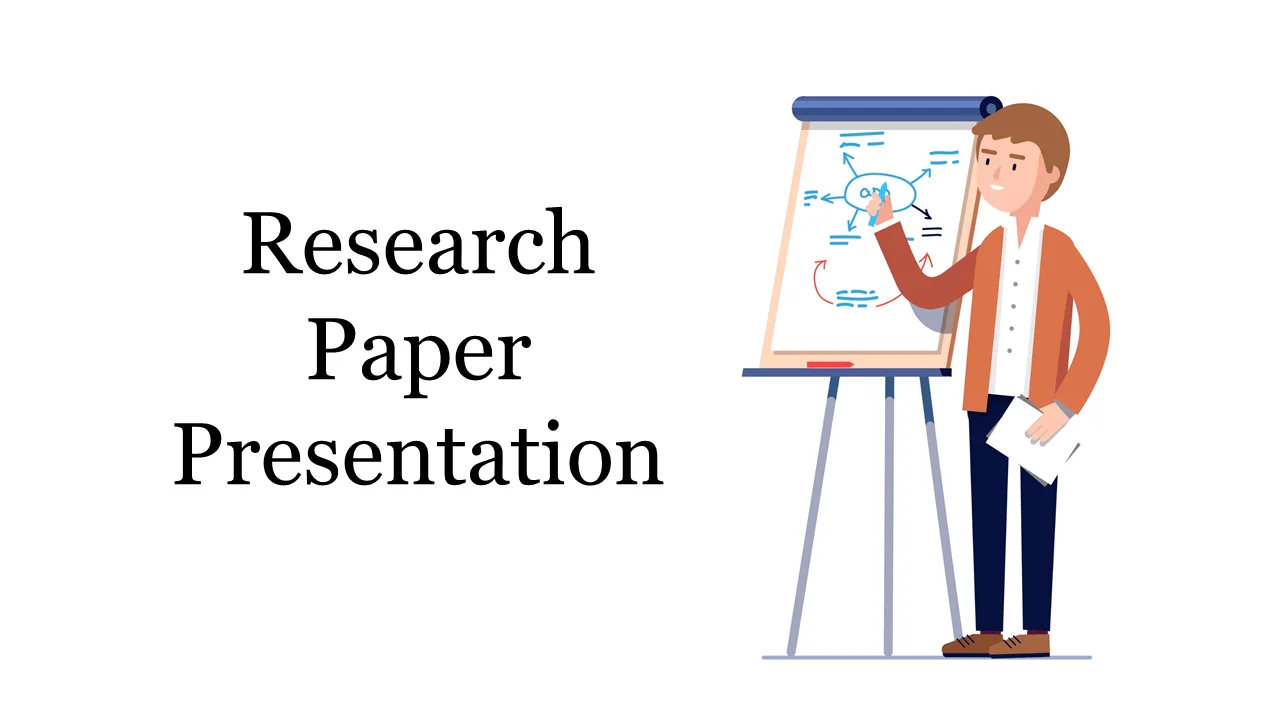
How to Present a Research Paper using PowerPoint [Sample + Tips]
posted on September 30, 2017
- Facebook 831
Spending couple of months or years in research seems less difficult as compared to presenting it. Presenting your research work to a bunch of experts can be very difficult sometimes. Your audience will only like well-crafted presentation.
There are certain things you need to take care of. Presenting a research paper is quite different from a talk or any other presentation. In research paper presentation, you are going to discuss everything that you have done and achieved during your research in limited time.
There is a specific outline that experts recommend that you must follow during your research paper presentation.
Research Paper Presentation Outline
Introduction.
Give the brief introduction of your work. For example, if you are going to work on a disease than describe the
disease. Focus on the things on which you have worked on. If you are working on genes of that disease then it will be important discuss the genetic pathways of the disease in your introduction.
You may discuss the “problem” on which you have worked on during your research.
Things that you need to remember,
- Focus on the relevant information
- Do not more than 3 slides on the introduction
Methodology
It’s about the recipe and spices of your research work. Mention all the materials that were required to do the task and how miraculously you did it. Using flowcharts in your PowerPoint slides can help you to present it in the more engaging way.
Try to fit it in 2 slides only. Emphasis on any special equipment or build that you have used during your work.
Tell your audience about the verifiable objectives you had while doing this research. It doesn’t matter if they vary from your results, it is necessary to tell the audience what were you looking for.
- Consume only one slide
- Make it concise
- You are allowed to use fancy words or good vocabulary here
Results and Discussion
Write down your results, most possibly in the form of the table. Try not to confuse your audience with so much numerical data so charts will work fine. Highlight if you have something novel in your results.
Try to interpret your results in 2-3 points. The conclusion must be very meaningful for audiences. It must not be ambiguous. Usually, a single statement is enough.
Future Recommendations
What can be done more on your particle topic? This is very important if you are going to pursue the same topic in your further studies. It will help you to have a future objective for yourself.
Tips for Research Paper Presentations
- There should be 5*5 rules in each slide. I.e. there are five words in one sentence and there should be five lines on one slide.
- Data should be in the form of small key points or bullets . Data should not be in paragraph form on the slide. It should be precise. Slides are not for the audience it just hints for the presenter. The presenter should explain all terms and every concept that is written on slide.
- Standard heading size is 44 while standard text size is 32.
- Make link of one slide with the second slide during the presentation. For example, tell the audience what they will listen and see in next slide.
- The template of PowerPoint presentation should not have shocking color. Text color should be in contrast with template color. If somewhere in slides text color is same as template audience would not be able to see what is written on it.
- There should be slide number on every slide except title slide.
- All slides should be in homogeneity. The presenter should use either upper case or lower case alphabets in the text of the whole presentation.
- There should be the use of animations but no use of transitions.
- There should be a table of content of presentation on the slide next to title slide. By explaining this presenter should give an overview of the whole presentation.
Paper Presentation Sample
To help our readers, I have made a template for paper presentation. I hope it will be helpful for you. Research paper presentation sample Download.
Share this:
- Click to share on Twitter (Opens in new window)
- Click to share on Facebook (Opens in new window)
- Click to share on LinkedIn (Opens in new window)
- Click to share on Reddit (Opens in new window)
- Click to share on Tumblr (Opens in new window)
- Click to share on Pinterest (Opens in new window)
- Click to share on Pocket (Opens in new window)
- Click to share on Telegram (Opens in new window)
- Click to share on WhatsApp (Opens in new window)
- Click to share on StumbleUpon (Opens in new window)
- Click to email a link to a friend (Opens in new window)
- Click to print (Opens in new window)
About Haseeb Ahmad
Author is a S&T Journalist and Entrepreneur. He Founded Jaamiah.com - Pakistan's Premier EdTech Startup.
Reader Interactions
September 30, 2017 at 8:31 pm
Simple and useful article. Keep it up, also write about ”Project Report ”
September 30, 2017 at 8:39 pm
Thank you for your kind response. I have pinned your request in our priority to-do list. Keep visiting our site.
May 19, 2018 at 11:56 am
well articulated. thanks for sharing this.
May 19, 2018 at 5:18 pm
Dear Badmus, Thank you for your kind remarks. Please keep visiting and sharing our website
May 25, 2018 at 12:20 am
Hey, nice work.I will love to have a copy of this work sent to my mail, ( [email protected] ),thanks a million
May 25, 2018 at 2:39 pm
Dear keke You can use the “email” share option at the bottom of the article. Thank you for endorsing our work
September 26, 2018 at 8:12 pm
Can you mail it on gmail
September 30, 2018 at 2:59 pm
Dear Vrushikesh, You can download it just by clicking the links. If failed to do so, Please feel free to comment again. I’ll email you
October 22, 2018 at 5:08 am
can you send me the file? the file cant be read. [email protected]
Leave a Reply Cancel reply
Academia.edu no longer supports Internet Explorer.
To browse Academia.edu and the wider internet faster and more securely, please take a few seconds to upgrade your browser .
Enter the email address you signed up with and we'll email you a reset link.
- We're Hiring!
- Help Center

How to write a research paper?

The presentation addresses different issues relating to writing research papers.
Related Papers
Journal of Universal College of Medical Sciences
bishal joshi
INTRODUCTION A research paper is a part of academic writing where there is a gathering of information from different sources. It is multistep process. Selection of title is the most important part of research writing. The title which is interesting should be chosen for the research purpose. All the related information is gathered and the title for research is synthesized. After thorough understanding and developing the title, the preliminary outline is made which maintains the logical path for its exploration. After preliminary research, proper research work is started with collection of previous resources which is then organized and important points are noted. Then research paper is written by referring to outlines, notes, articles, journals and books. The research paper should be well structured containing core parts like introduction, material and methods, results and disscussion and important additional parts like title, abstract, references.
Kevin O'Donnell
Sher Singh Bhakar
Organisation of Book: The book is organized into two parts. Part one starts with thinking critically about research, explains what is (and isn’t) research, explains how to properly use research in your writing to make your points, introduces a series of writing exercises designed to help students to think about and write effective research papers. Instead of explaining how to write a single “research paper,” The Process of Research Writing part of the book breaks down the research process into many smaller and easier-to manage parts like what is a research paper, starting steps for writing research papers, writing conceptual understanding and review of literature, referencing including various styles of referencing, writing research methodology and results including interpretations, writing implications and limitations of research and what goes into conclusions. Part two contains sample research articles to demonstrate the application of techniques and methods of writing good resear...
Tips for Writing a Research Paper
Rachel M. Laisne
Writing a good research paper involves proper preparation. A small amount of time preparing in advance with your materials will provide you with the organization needed to puttl a good research paper together.
josé António C. Santos , Tourism & Management Studies
Journal of Emerging Technologies and Innovative Research, ISSN-2349-5162
Siva Prathap , M Kamraju , Mohd Akhter Ali
Research papers are highly recognized in scholar fraternity. In addition to that the published research work provides a big weight-age to career growth and helps to get admission in reputed universities. Research Scholars doing Ph.D it has become mandatory to publish their research papers at international level academic Journals or scholarly (Peer Reviewed) journals. And many of the students who wish to apply for further studies in technical courses will discover that relevant published research papers help during admission process.So, in this paper we will highlight and enlist the proven steps to write the research paper for peer-reviewed journals.
guidelines and notes
Jeff Immanuel
Hossein Saiedian
Shendry Rosero
Loading Preview
Sorry, preview is currently unavailable. You can download the paper by clicking the button above.
RELATED PAPERS
Neal Carboneau
Jurnal Kedokteran Hewan - Indonesian Journal of Veterinary Sciences
bayu rosadi
Indonesian Journal of Chemistry
Sri Noegrohati
Come Hell or High Water: Feminism and the Legacy of Armed Conflict in Central America
Tine Destrooper
quignard jean-pierre
kamyab shahriari
Hathaikarn Manuspiya
Ege Üniversitesi Su …
Emre Türker
Editora BAGAI
International Journal of Cardiology
Nurys Barbara Armas Rojas
IEEE Transactions on Signal Processing
Huseyin Akcay
Acta Agronomica
edgar uriel vicuña lozano
Organic & Biomolecular Chemistry
Agnes Mingot
Journal of Contemporary Medicine
tugba karatas
Suma Psicológica
Camila Angulo Parra
International Journal of Engineering Research and
sanjay tahiliani
John Kampen
Outlooks on Pest Management
Ken PALLETT
Marine Ecology Progress Series
Muhafazakâr Düşünce Dergisi
Muhafazakar Düşünce - Dergisi
arXiv (Cornell University)
Naftaly Minsky
Scientific Reports
Flora the Journal of Infectious Diseases and Clinical Microbiology
Meriç Özgenel
Universitas Médica
elias quintero
RELATED TOPICS
- We're Hiring!
- Help Center
- Find new research papers in:
- Health Sciences
- Earth Sciences
- Cognitive Science
- Mathematics
- Computer Science
- Academia ©2024
Home PowerPoint Templates PowerPoint Templates Research Paper Presentation Template
Research Paper Presentation Template
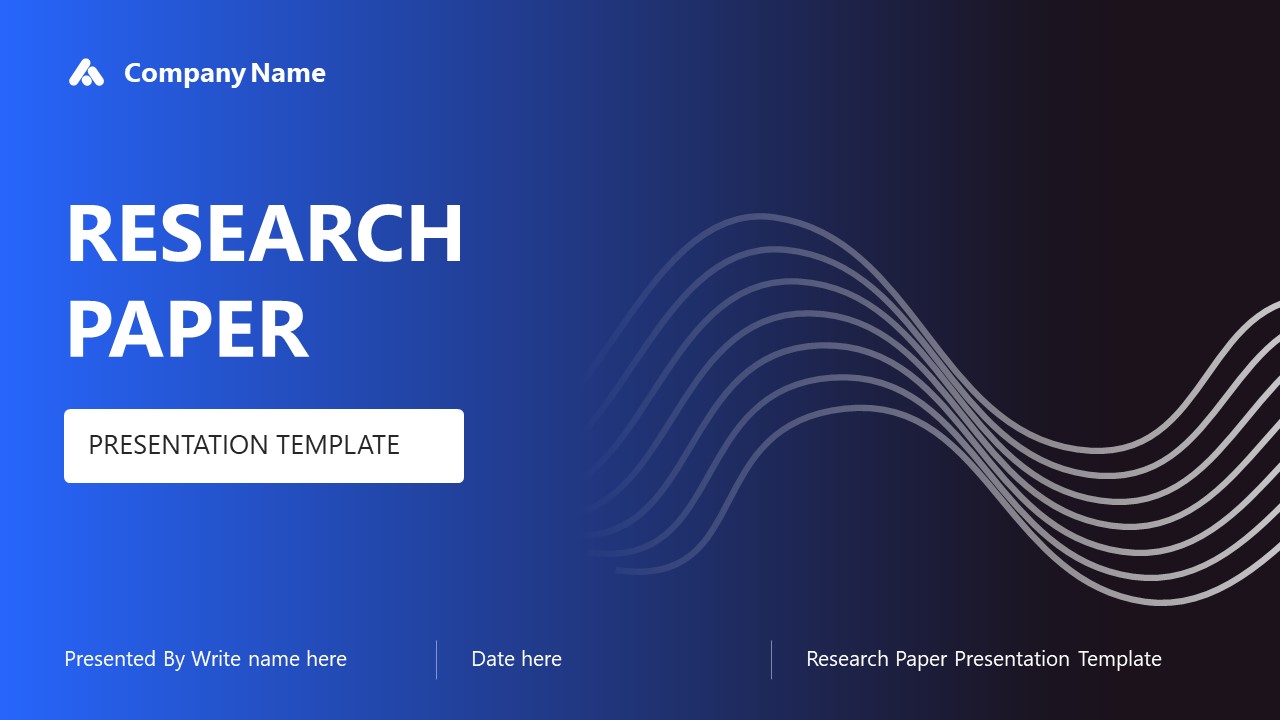
Introduce key aspects of your research paper with a catchy layout by using our Research Paper Presentation Template . A research paper is a formal documentation that outlines the key research methodology for solving a particular problem. This is associated with all the domains of study and analysis. For instance, biologists can write down a research paper to clarify the factors causing a disease, and physics experts can present a research analysis paper to demonstrate the significant scientific parameters of a technique or process. We have crafted this template for research paper presentations. Professionals, experts, scholars, and students can use this template in academic or educational presentations .
The Research Paper Presentation Template starts with a title slide displaying the topic of the research presentation . Next, there is an agenda slide and a slide showing the examination’s background. In the problem statement slide, presenters can display the scope of the study, its relevance, and the associated research questions. Moreover, in the methodology slide, users can mention their qualitative or quantitative approach for their examination. Further, there is a horizontal timeline slide where professionals can explain the stages of their research analysis. The whiteboard slides at the end of the presentation template can help presenters engagingly discuss the key points. They can also use attractive data visualizations to illustrate the data points comprehensively and clearly.
The template has a simple and modern design that helps researcher convey their research analysis outcomes to the audience in an understandable way. Users can change the PowerPoint features like shapes, colors, and infographics used in the template according to their requirements. Download this research paper PPT template and present your findings with high-end graphics!
You must be logged in to download this file.
Favorite Add to Collection
Details (12 slides)

Supported Versions:
Subscribe today and get immediate access to download our PowerPoint templates.
Related PowerPoint Templates
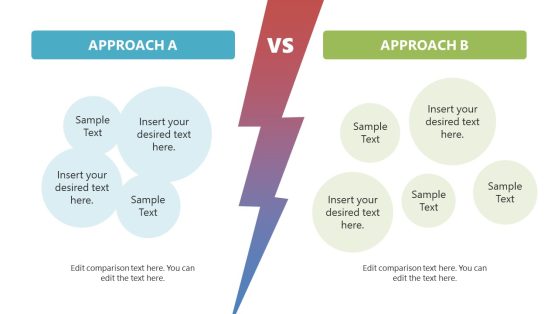
Compare Two Approaches PowerPoint Template
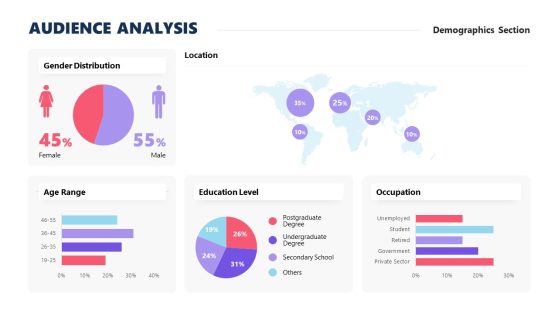
Audience Analysis PowerPoint Template
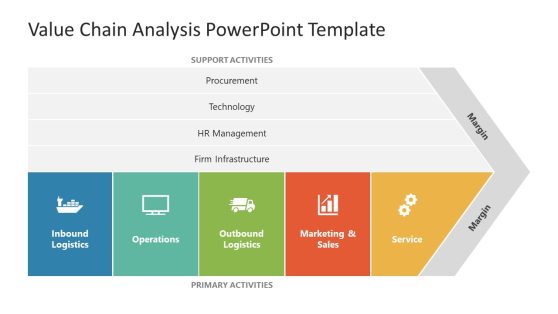
Value Chain Analysis PowerPoint Template

Book Report Presentation Template

How to Convert Academic Research papers to PowerPoint for effective Presentation delivery
Unlock the art of presenting research papers with ease! Learn to convert them into PowerPoint.
Sanskar Tiwari
Step 1: Visit Google Slides
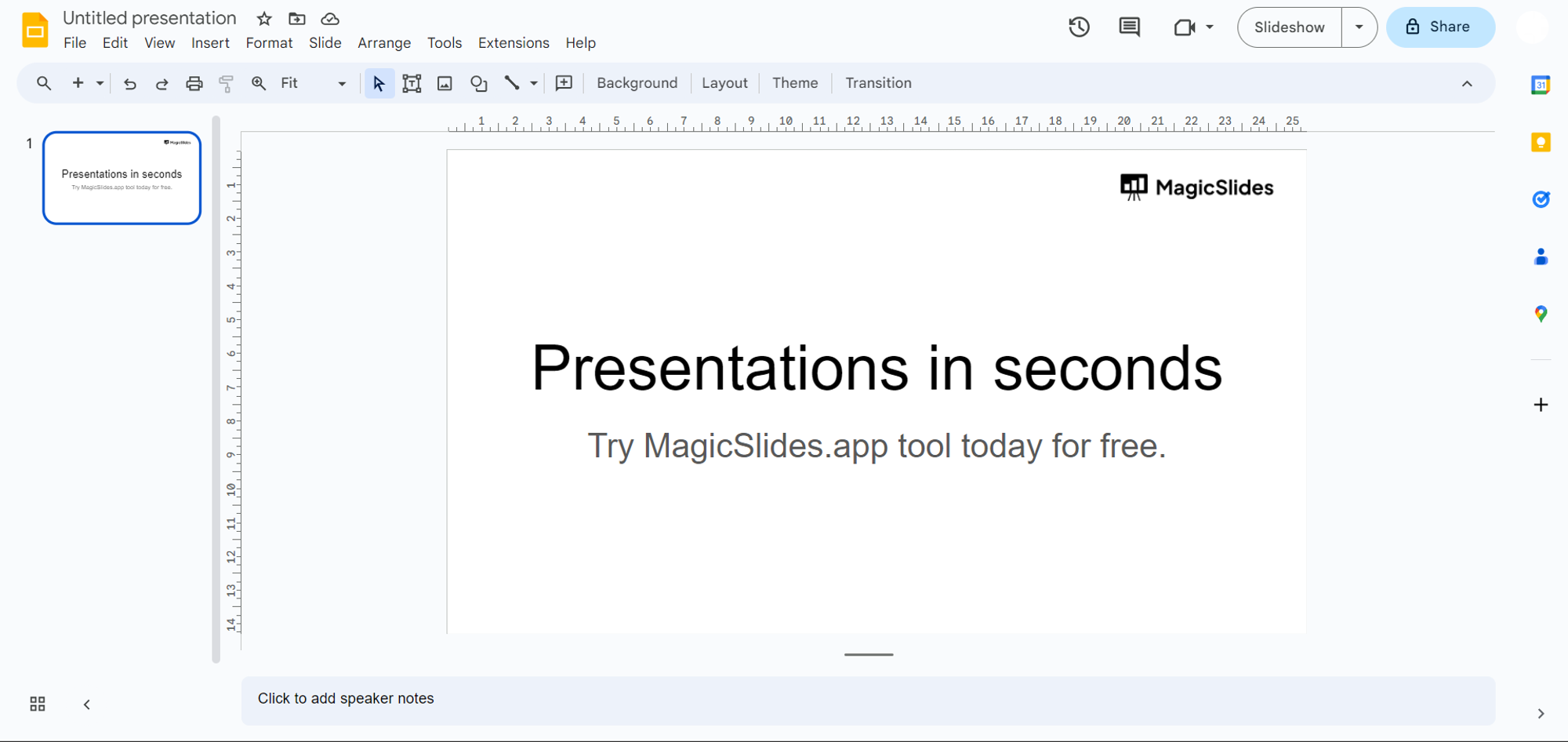
Step 2: Download MagicSlides Extension
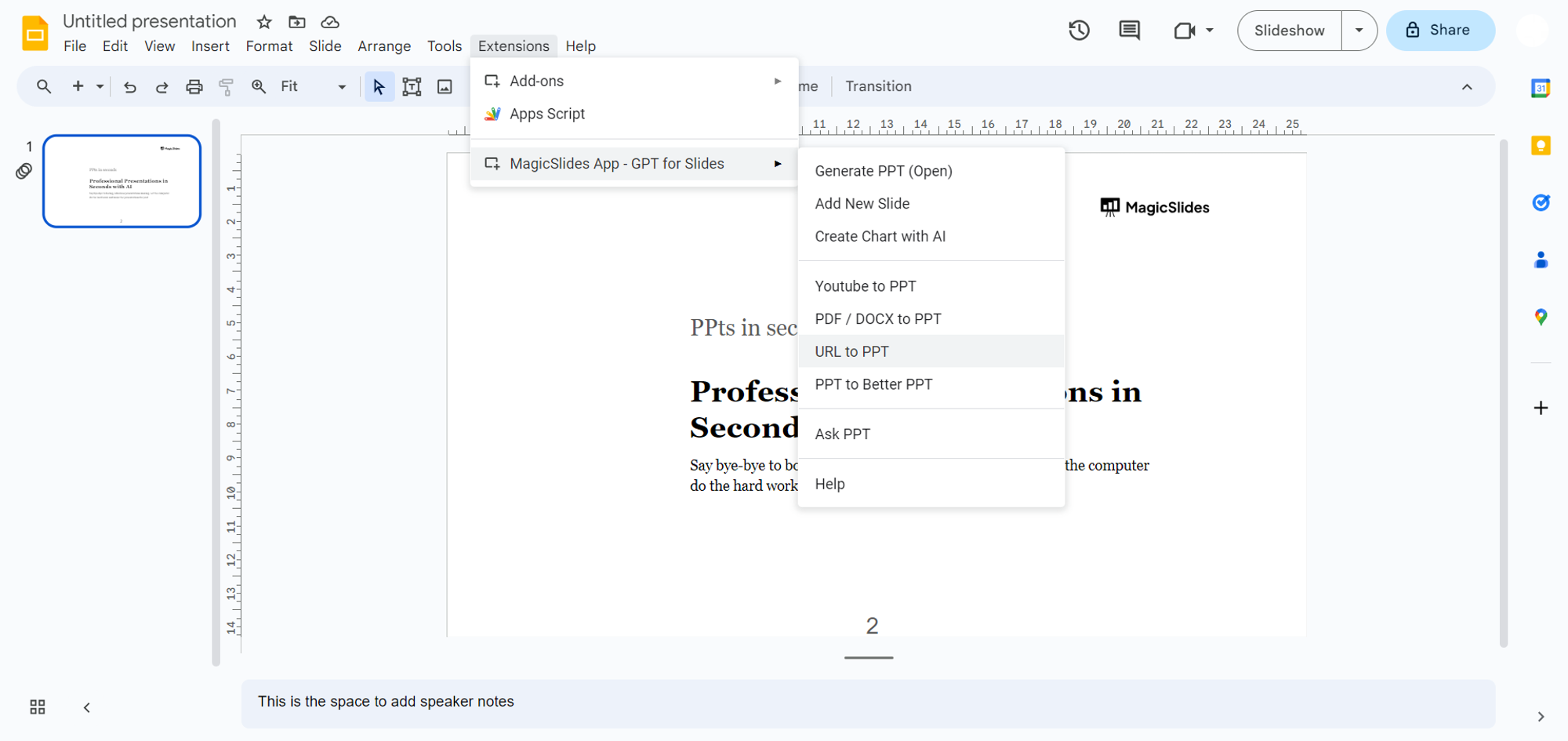
Step 3: Locate Your Research Paper
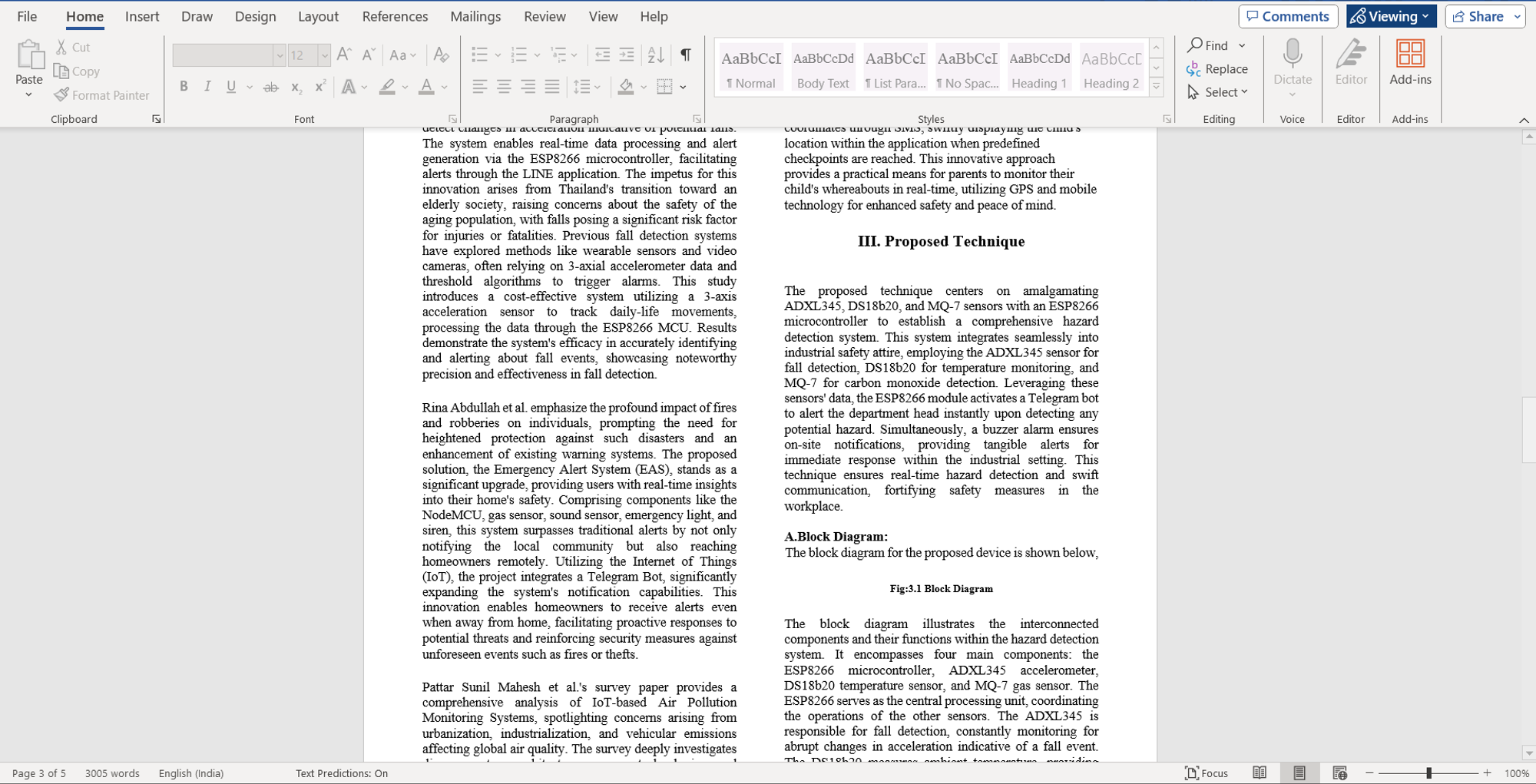
Step 4: Upload the Research Paper
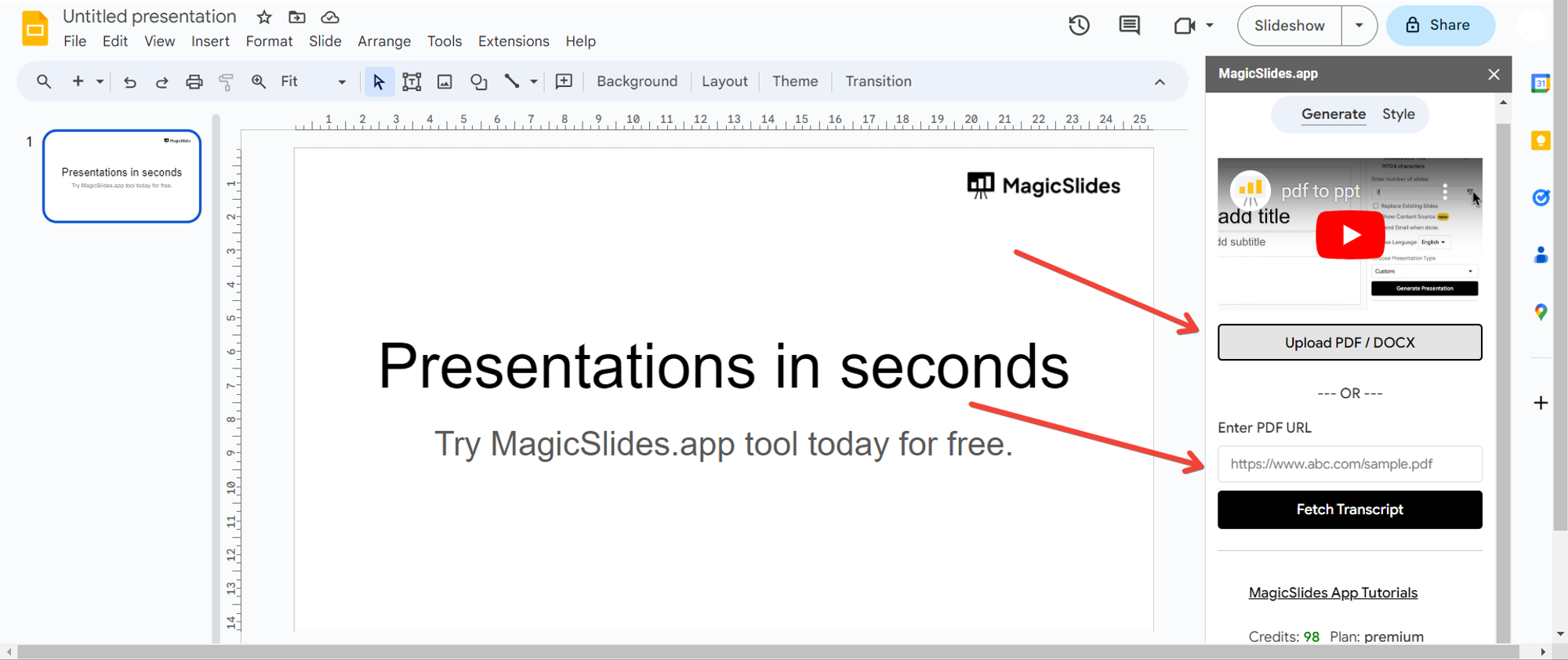
Step 5: Click "Generate Presentation"
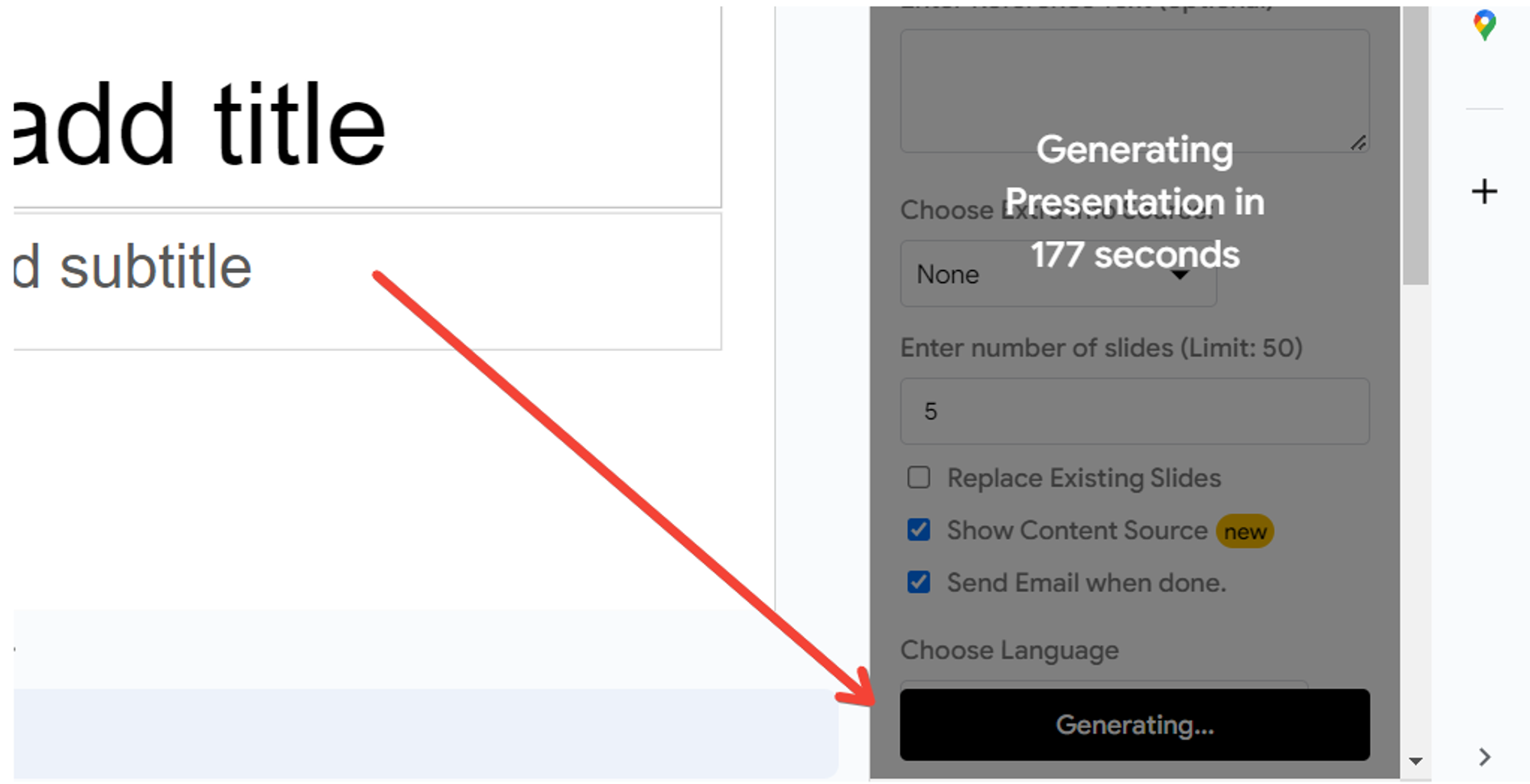
Step 6: Your Research Paper is Now a PowerPoint Presentation
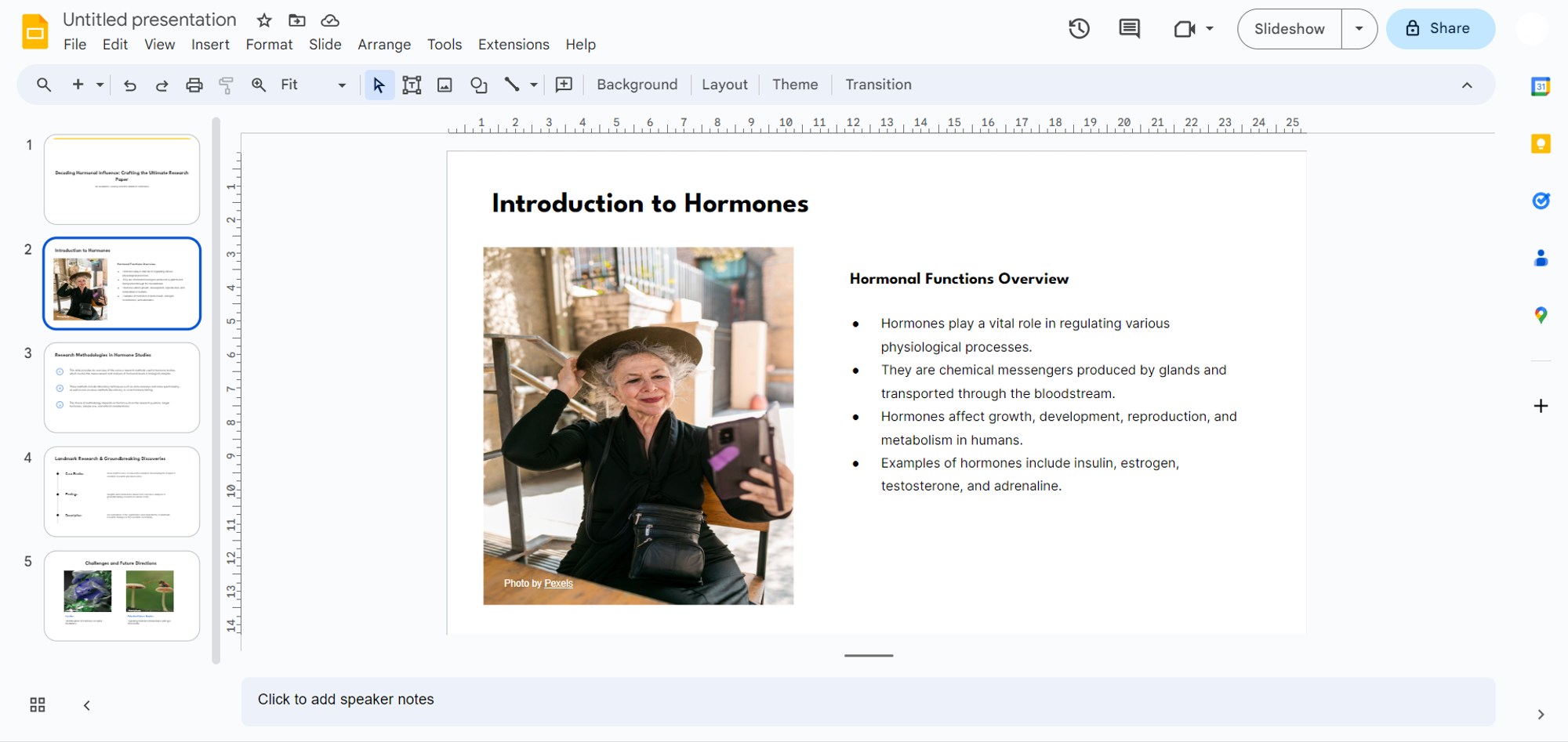
Conclusion:
Frequently asked questions:, related blogs, how to create presentation summaries from academic lesson pdfs.
How to convert Word reports to PowerPoint presentations for professional summaries?
How to transform resumes in pdf into creative ppt slides, how to generate powerful ppts from paragraphs in minutes, how to summarize educational content into engaging presentations, how to convert tech article summaries to ppt slides for quick review, how to transform health article summaries into informative ppts, how to convert a pdf to ppt file, stunning presentations in seconds with ai.
Install MagicSlides app now and start creating beautiful presentations. It's free!

~1M Installs, rated 4.5/5 ⭐️ by 424 reviews
Got any suggestions?
We want to hear from you! Send us a message and help improve Slidesgo
Top searches
Trending searches

suicide prevention
8 templates

46 templates

tropical rainforest
29 templates

spring season
34 templates

american football
16 templates

32 templates
Research Presentation templates
Customize our free themes and templates for google slides or powerpoint and explain what your research is about. these designs are easy to edit, so that will speed things up.

Formal Research Paper Slideshow
Have you seen these slides? They are perfect for presenting your research paper! First of all, because we have included all the necessary sections of this type of work, such as hypothesis, objectives, methodology, analysis and the conclusions of the paper. The second reason is that the formal style will...
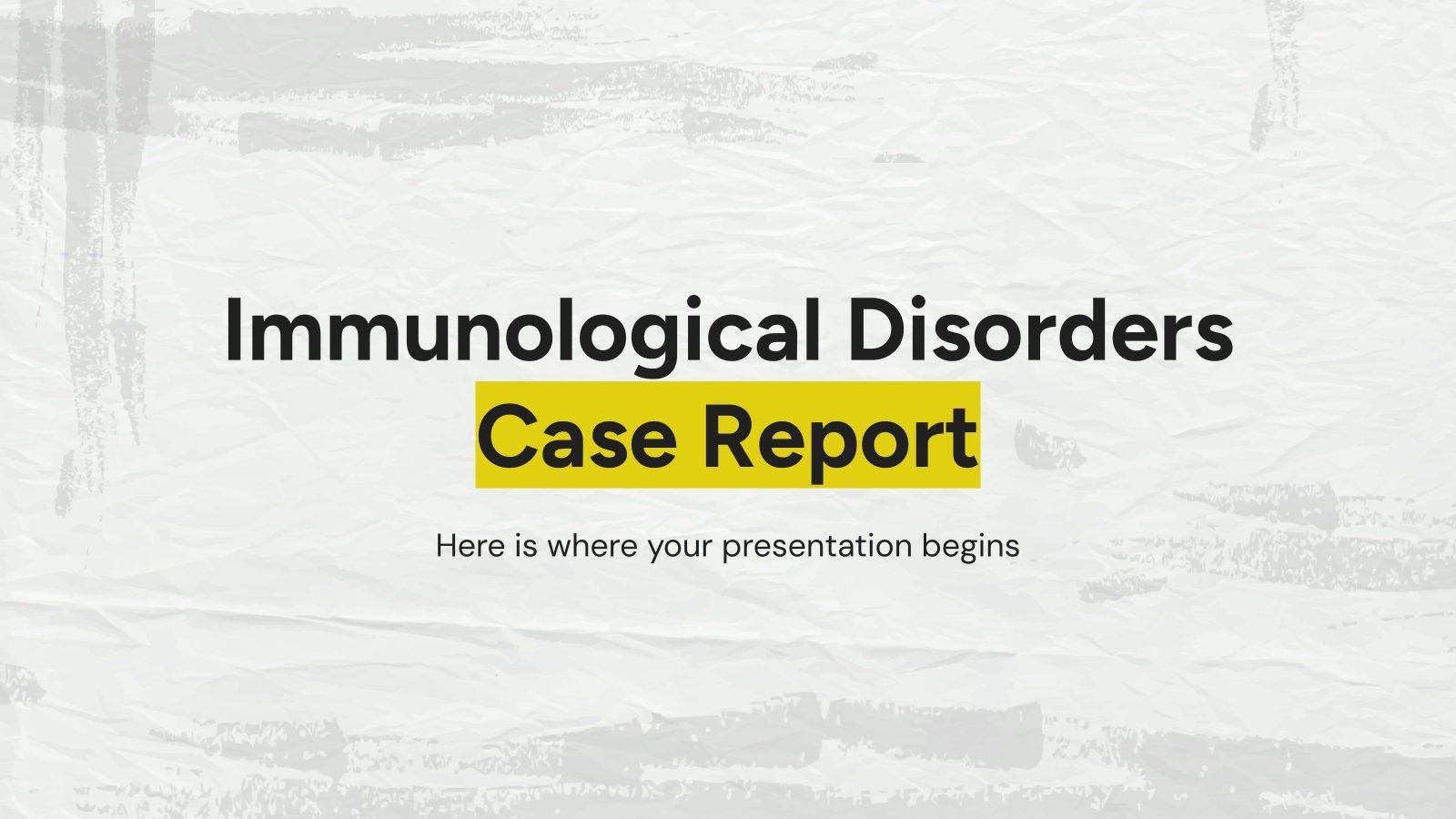
Immunological Disorders Case Report
Download the "Immunological Disorders Case Report" presentation for PowerPoint or Google Slides. A clinical case is more than just a set of symptoms and a diagnosis. It is a unique story of a patient, their experiences, and their journey towards healing. Each case is an opportunity for healthcare professionals to...

Implantation of Hearing Aids in Children Case Report
Download the "Implantation of Hearing Aids in Children Case Report" presentation for PowerPoint or Google Slides. A clinical case is more than just a set of symptoms and a diagnosis. It is a unique story of a patient, their experiences, and their journey towards healing. Each case is an opportunity...
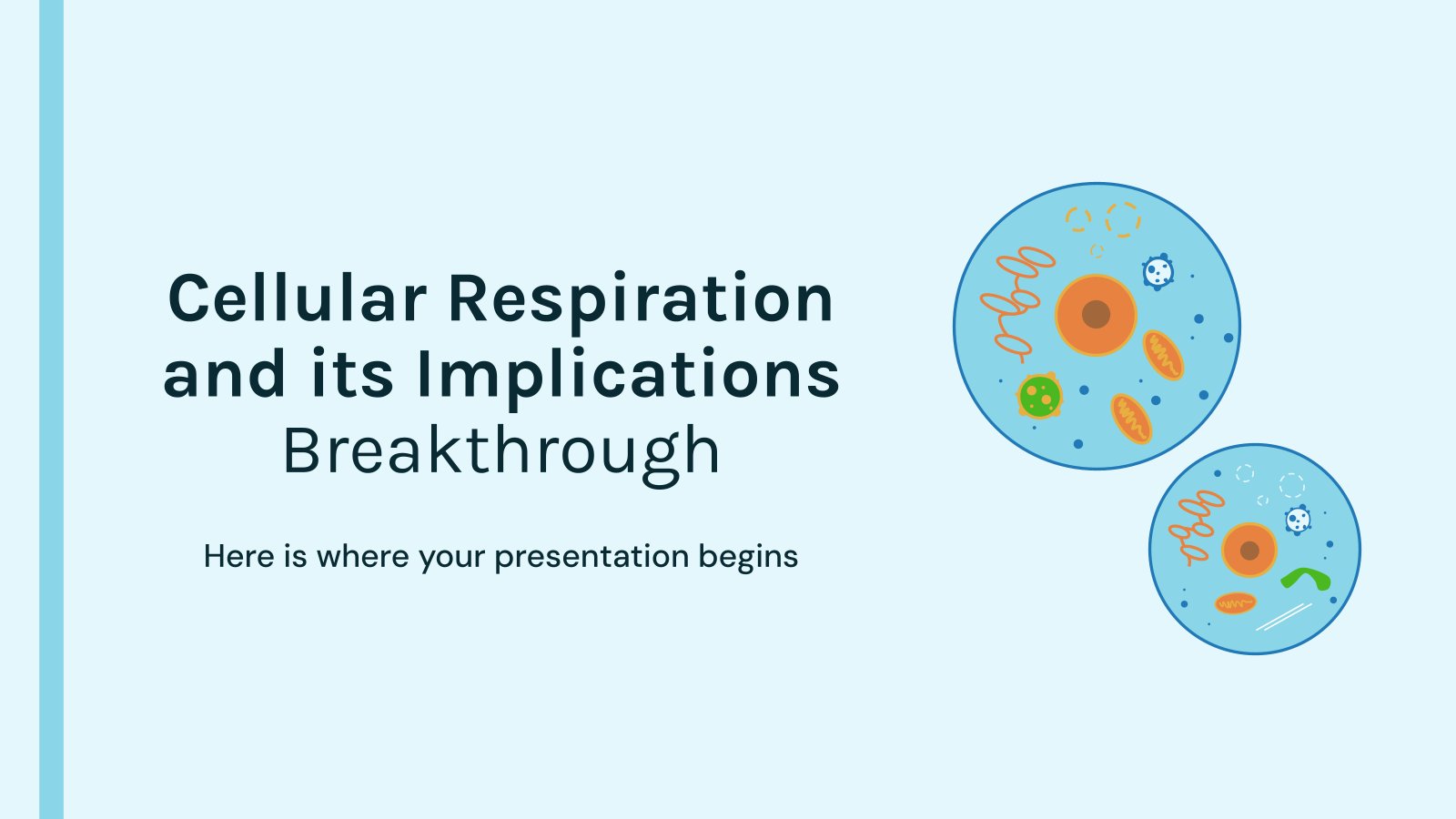
Cellular Respiration and its Implications Breakthrough
Download the "Cellular Respiration and its Implications Breakthrough" presentation for PowerPoint or Google Slides.Treating diseases involves a lot of prior research and clinical trials. But whenever there’s a new discovery, a revolutionary finding that opens the door to new treatments, vaccines or ways to prevent illnesses, it’s great news. Should...

Premium template
Unlock this template and gain unlimited access
Project Research Infographics
Download the "Project Research Infographics" template for PowerPoint or Google Slides and discover the power of infographics. An infographic resource gives you the ability to showcase your content in a more visual way, which will make it easier for your audience to understand your topic. Slidesgo infographics like this set...

Thesis Proposal and Writing - Master of Arts in History
Download the "Thesis Proposal and Writing - Master of Arts in History" presentation for PowerPoint or Google Slides. As university curricula increasingly incorporate digital tools and platforms, this template has been designed to integrate with presentation software, online learning management systems, or referencing software, enhancing the overall efficiency and effectiveness...

Medical Collaboration Research
Download the "Medical Collaboration Research" presentation for PowerPoint or Google Slides. Gone are the days of dreary, unproductive meetings. Check out this sophisticated solution that offers you an innovative approach to planning and implementing meetings! Detailed yet simplified, this template ensures everyone is on the same page, contributing to a...

Pregnancy Breakthrough
Giving birth to a baby is a beautiful occasion, a manifestation of love between two people. Obstetrics are key during pregnancy, so how about giving a presentation about the latest breakthrough in this field? Our free medical template will come in handy.

Economics Thesis
If numbers, exchange rates, money and trading are your forte, odds are you’re already working on an economics thesis for your master’s degree. Defending your dissertation is the last step and the most difficult one, but Slidesgo can help you. Here’s our new free presentation template with a focus on...

Nursing Capstone
In medical contexts, a capstone is often the final course in a nursing degree, a project of vital importance. It’s very demanding, so if you need help with the presentation, use this free professional template. Leave the design to us and focus on your data!
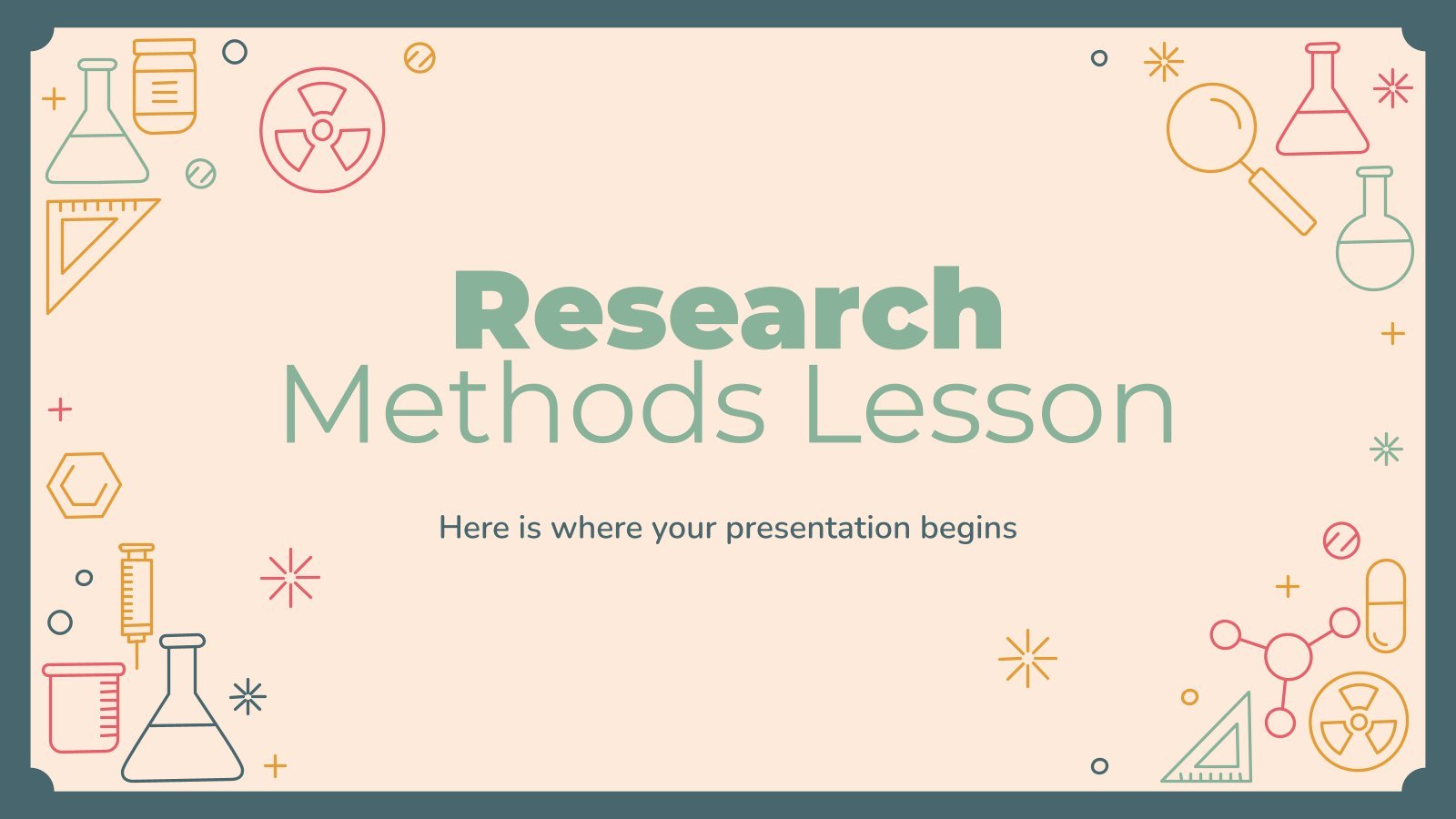
Research Methods Lesson
If you deal with Science, it’s important to learn more about research methods. Teach your students about them with this presentation full of illustrations and drawings related to labs. Use graphs, maps, tables and overview diagrams to support your lecture in a visual way!

Final Year Project Thesis Defense
Download the "Final Year Project Thesis Defense" presentation for PowerPoint or Google Slides. Congratulations, you have finally finished your research and made it to the end of your thesis! But now comes the big moment: the thesis defense. You want to make sure you showcase your research in the best...

Qualitative Research Methods - Doctor of Philosophy (Ph.D.) in Health Behavior and Health Education
Download the "Qualitative Research Methods - Doctor of Philosophy (Ph.D.) in Health Behavior and Health Education" presentation for PowerPoint or Google Slides. As university curricula increasingly incorporate digital tools and platforms, this template has been designed to integrate with presentation software, online learning management systems, or referencing software, enhancing the...

AP Research Defense for High School
AP, or Advanced Placement, is a North American educational program that offers a rigorous course designed to challenge and prepare high school students for their future careers and academic pursuits. It requires students to conduct independent research, write a lengthy academic paper, and present their findings to a panel of...

Elegant Black & White Thesis Defense
Present your research findings with grace and assertiveness through this template. Available for Google Slides and PowerPoint, this design set offers minimalistic charm with its simple, gray scale elegance. The template not only provides a polished platform to showcase your thesis but also ensures seamless and efficient delivery of your...
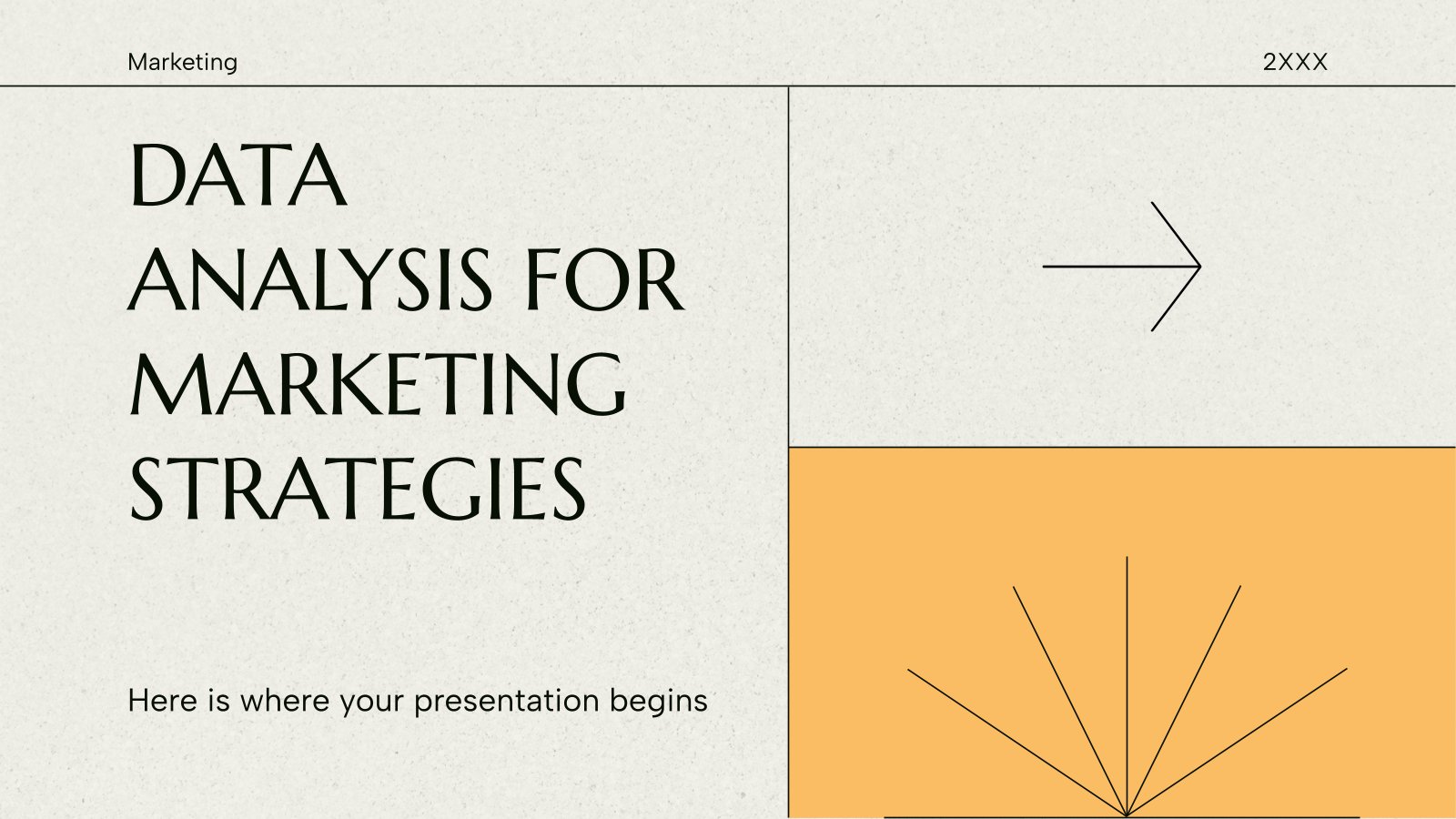
Data Analysis for Marketing Strategies
With the amount of data available through various digital platforms, it's easier than ever to determine the trends and preferences of your target audience. By collecting and analyzing data, marketers can create highly personalized campaigns that align with the exact needs and wants of their customers. If you're trying to...

Research Project Proposal
Before embarking yourself on a new project, especially if it’s about research, you need to set out a proposal to explain its viability. Here at Slidesgo we’re offering this theme that you can actually use for any kind of project, regardless of the topic.

SWOT Analysis Infographics
Discover the strengths, weaknesses, opportunities and threats of your own company performing a SWOT analysis. Use this basic strategic planning to evaluate your position with these new infographics created by Slidesgo.
- Page 1 of 79
New! Make quick presentations with AI
Slidesgo AI presentation maker puts the power of design and creativity in your hands, so you can effortlessly craft stunning slideshows in minutes.

Register for free and start editing online
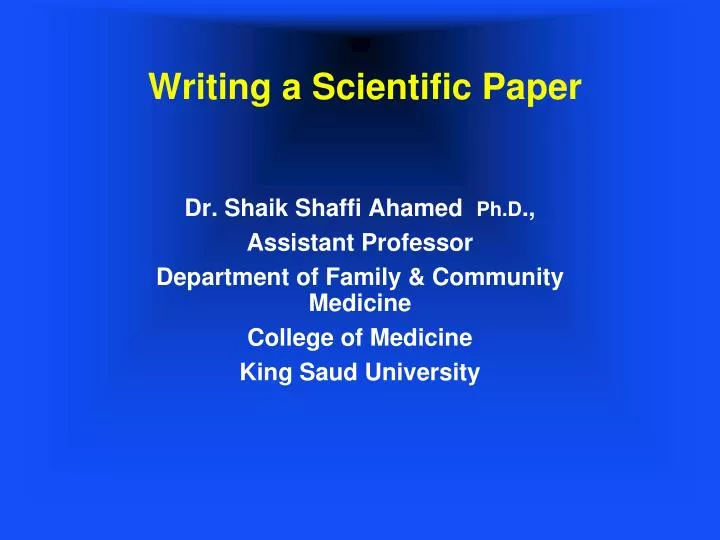
Writing a Scientific Paper
Mar 15, 2019
920 likes | 1.58k Views
Writing a Scientific Paper. Dr. Shaik Shaffi Ahamed Ph.D ., Assistant Professor Department of Family & Community Medicine College of Medicine King Saud University. What is a Scientific Paper ?. A scientific paper is a written and published report describing original research results.
Share Presentation
- results section
- main section
- section heading
- results section concisely
- journal style scientific paper

Presentation Transcript
Writing a Scientific Paper Dr. Shaik Shaffi Ahamed Ph.D., Assistant Professor Department of Family & Community Medicine College of Medicine King Saud University
What is a Scientific Paper ? A scientific paper is a written and published report describing original research results
WHAT IS A SCIENTIFIC PAPER? • It is an addition to human knowledge; this is a reversible statement (addition of knowledge takes place through scientific papers) Sharks (reviewers) Island of Human Knowledge OCEAN OF IGNORANCE your paper • A scientific paper is not: • a technical report or term paper • a paper is worth writing only if it has general implications for knowledge • a gospel • paper should be scholarly but you’re not writing for the ages – others will come after you with newer data and better models.
The Structure, Format, Content, and Style of a Journal-Style Scientific Paper
Why a Scientific Format? • It is a means of efficiently communicating scientific findings to the broad community of scientists in a uniform manner. • This format allows the paper to be read at different levels.
The Sections of the Paper • Title, • Authors and Affiliation, • Abstract, • Introduction, • Methods, • Results, • Discussion, • Acknowledgments, and • References,
The sections appear in a journal style paper in the following prescribed order:
Section Headings: • Main Section Headings: Each main section of the paper begins with a heading which should be capitalized, centered at the beginning of the section, and double spaced from the lines above and below. Do not underline the section heading OR put a colon at the end. • Example of a main section heading: INTRODUCTION
Subheadings: When your paper reports on more than one experiment, use subheadings to help organize the presentation. Subheadings should be capitalized (first letter in each word), left justified, and either bolditalics OR underlined. • Example of a subheading: Effect of age on Blood pressure values
INTRODUCTION Function: • It establish the context of the work being reported. This is accomplished by discussing the relevantprimary research literature (with citations) and summarizing our current understanding of the problem you are investigating; • State the purpose of the work in the form of the hypothesis, question, or problem you investigated; and, • Briefly explain your rationale and approach and, whenever possible, the possible outcomes your study can reveal.
The Introduction must answer the questions • "What we are studying? • Why it an important question? • What did we know about it before wedid this study? • How will this study advance our knowledge?"
Style: • Use the active voice as much as possible. • Not to use the first person.
At all costs, avoid the passive voice. “All patients screened were asked to complete an acceptability questionnaire immediately after screening” (not good) versus “ All patients were completed an acceptability questionnaire immediately after screening” (good) “The genes were seen to be expressed…. (not good) versus “The genes were expressed….” (good)
Structure: • The structure of the Introduction can be thought of as an inverted triangle - the broadest part at the top representing the most general information and focusing down to the specific problem you studied. • Organize the information to present the more general aspects of the topic early in the Introduction, then narrow toward the more specific topical information that provides context, finally arriving at your statement of purpose and rationale.
MATERIALS AND METHODS This section is variously called Methods or Methods and Materials. Function: • In this section you explain clearly how you carried out your study in the following general structure and organization
The Subjects studied (plant, animal, human, etc.) and when (study period) and where the study was carried out. • Description of the sample size, inclusion/exclusion criteria, study variables, outcome variables, and its measurement.
The experimental OR sampling design (i.e., how the experiment or study was structured. For example, controls, treatments, the variable (s) measured, how many samples were collected, replication, etc.); • The method for collecting data, i.e., how the experimental procedures were carried out, and, • How the data were analyzed (qualitative analyses and/or statistical procedures used).
The information should include: • how the data were summarized (Means, percent, etc) and how you are reporting measures of variability (SD,SEM, etc) • this lets you avoid having to repeatedly indicate you are using mean ± SD. • data transformation, if any.
statistical tests used with reference to the particular questions they address, e.g., • "A Paired t-test was used to compare mean weight before and after intervention“ • "One way ANOVA was used to compare mean weight gain in three different groups“ • any other numerical or graphical techniques used to analyze the data
Style: • The style in this section should read as if you were verbally describing the conduct of the experiment. • You may use the active voice to a certain extent, although this section requires more use of third person, passive constructions than others. • Avoid use of the first person in this section. Remember to use the past tense throughout - the work being reported is done, and was performed in the past, not the future.
RESULTS Function: • The function of the Results section is to objectively present your key results, without interpretation, in an orderly and logical sequence using both illustrative materials (Tables and Figures) and text. • Summaries of the statistical analyses may appear either in the text (usually parenthetically) or in the relevant Tables or Figures (in the legend or as footnotes to the Table or Figure). • The Results section should be organized around a series of Tables and/or Figures sequenced to present your key findings in a logical order.
The text of the Results section follows this sequence and highlights the answers to the questions/hypotheses you investigated. • Important negative results should be reported, too. • Authors usually write the text of the results section based upon the sequence of Tables and Figures.
Style: • Write the text of the Results section concisely and objectively. • Use the past tense. • Avoid repetitive paragraph structures. • Do not interpret the data here.
Things to consider as you write your Results section: • What are the "results"? • Organize the results section based on the sequence of Table and Figures you'll include
Simple rules to follow related to Tables and Figures: • Tables and Figures are assigned numbers separately and in the sequence that you will refer to them from the text. • The first Table you refer to is Table 1, the next Table 2 and so forth. • Similarly, the first Figure is Figure 1, the next Figure 2, etc
Each Table or Figure must include a brief description of the results being presented and other necessary information in a legend. • Table legends go above the Table; tables are read from top to bottom. • Figure legends go below the figure; figures are usually viewed from bottom to top.
When referring to a Figure from the text, "Figure" is abbreviated as Fig., e.g., Fig. 1. Table is never abbreviated, e.g., Table 1. • The body of the Results section is a text-based presentation of the key findings which includes references to each of the Tables and Figures.
Some things to avoid: • Do not reiterate each value from a Figure or Table - only the key result or trends that each conveys. • Do not present the same data in both a Table and Figure. Decide which format best shows the result and go with it. • Do not report raw data values when they can be summarized as means, percents, etc.
Present the results of your experiment (s) in a sequence that will logically support (or provide evidence against) the hypothesis, or answer the question, stated in the Introduction. • Report negative results - they are important!
Always enter the appropriate units when reporting data or summary statistics. • for an individual value you would write, "the mean length was 10 m", or, "the maximum time was 140 min." • When including a measure of variability, place the unit after the error value, e.g., "...was 10 ± 2.3 m". • Likewise place the unit after the last in a series of numbers all having the same unit. For example: "lengths of 5, 10, 15, and 20 m", or "no differences were observed after 2, 4, 6, or 8 min. of incubation".
Discussion Function: • The function of the Discussion is to interpret your results in light of what was already known about the subject of the investigation, and to explain our new understanding of the problem after taking your results into consideration. • The Discussion will always connect to the Introduction by way of the question (s) or hypotheses you posed and the literature you cited, but it does not simply repeat or rearrange the Introduction. • Instead, it tells how your study has moved us forward from the place you left us at the end of the Introduction.
Fundamental questions to answer here include: • Do your results provide answers to your testable hypotheses? If so, how do you interpret your findings? • Do your findings agree with what others have shown? If not, do they suggest an alternative explanation or perhaps a unforeseen design flaw in your experiment (or theirs?) • Given your conclusions, what is our new understanding of the problem you investigated and outlined in the Introduction? • If warranted, what would be the next step in your study, e.g., what experiments would you do next?
Style: • Use the active voice whenever possible in this section. • Watch out for wordy phrases; be concise and make your points clearly.
Approach: • Organize the Discussion to address each of the experiments or studies for which you presented results; discuss each in the same sequence as presented in the Results, providing your interpretation of what they mean in the larger context of the problem. • Do not waste entire sentences restating your results; if you need to remind the reader of the result to be discussed, use "bridge sentences" that relate the result to the interpretation: • "The slow response of the lead-exposed neurons relative to controls suggests that...[interpretation]".
You must relate your work to the findings of other studies - including previous studies you may have done and those of other investigators. • Do not introduce new results in the Discussion.
Acknowledgments (included as needed) • If, in your experiment, you received any significant help in thinking up, designing, or carrying out the work, or received materials from someone who did you a favor by supplying them, you must acknowledge their assistance and the service or material provided. • Place the Acknowledgments between the Discussion and the References.
ABSTRACT Function: An abstract summarizes the major aspects of the entire paper in the following prescribed sequence: the question (s) you investigated (or purpose), (from Introduction) state the purpose very clearly in the first or second sentence. the experimental design and methods used, (from Methods) clearly express the basic design of the study. Name or briefly describe the basic methodology used without going into excessive detail-be sure to indicate the key techniques used.
the major findings including key quantitative results, or trends (from Results) report those results which answer the questions you were asking identify trends, relative change or differences, etc. a brief summary of your interpretations and conclusions. (from Discussion) clearly state the implications of the answers your results gave you.
The Abstract helps readers to decide whether they want to read the rest of the paper, or it may be the only part they can obtain via electronic literature searches or in published abstracts.
Style: The Abstract is ONLY text. Use the active voice. Write your Abstract using concise, but complete sentences, and get to the point quickly. Use past tense. Maximum length should be 200-300 words, usually in a single paragraph.
The Abstract SHOULD NOT contain: lengthy background information, references to other literature, elliptical (i.e., ending with ...) or incomplete sentences, abbreviations or terms that may be confusing to readers, any sort of illustration, figure, or table, or references to them.
Strategy: Although it is the first section of your paper, the Abstract must be written last since it will summarize the paper. To begin composing your Abstract, take whole sentences or key phrases from each section and put them in a sequence which summarizes the paper. Then set about revising or adding words to make it all cohesive and clear. As you become more proficient you will most likely compose the Abstract from scratch.
Check your work: Once you have the completed abstract, check to make sure that the information in the abstract completely agrees with what is written in the paper. Confirm that all the information appearing the abstract actually appears in the body of the paper.
References Function: • The References section gives a numerical listing of the references that you actually cited in the body of your paper.
Citing References in the Body of the Paper • Throughout the body of your paper (primarily the Introduction and Discussion), whenever you refer to outside sources of information, you must cite the sources from which you drew information. • The simplest way to do this is to give number (s) chronologically in superscript at the end of sentence of the text., e.g., It has been found that cancer cases who are exposed to estrogens has lower survival time than the controls.1,2
When citing information from another's publication, be sure to report the relevant aspects of the work clearly IN YOUR OWN WORDS. • Provide a reference to the work as soon as possible after giving the information.
DO NOT DO THE FOLLOWING: • DO NOT USE DIRECT QUOTES From Published Material. Take the information and put it into your own words.
List of References in the Reference Section • List the references chronologically as appear in the text. • Each reference includes: reference number, author’s name, article title, journal title, year of publication, volume number, issue number and page number.
Formats for Complete Citations Used in the Reference Section • You must provide complete citations for each of the published articles cited in your paper. • The format for entries in the Reference section differs for books and for journal papers because different kinds of information must be provided.
Specific Format Models Journal Article: Single author1. Bugjuice B. Physiological effects of estrogen on mouse courtship behavior. J Physiol 1970; 40(2):140-145.
- More by User
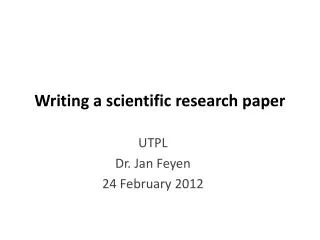
Writing a scientific research paper
Writing a scientific research paper. UTPL Dr. Jan Feyen 24 February 2012. Content. 1. Paper format. Title Authors, affiliation ABSTRACT INTRODUCTION MATERIALS AND METHODS RESULTS AND DISCUSSION CONCLUSIONS Acknowledgements References. Title Authors, affiliation ABSTRACT
1.44k views • 58 slides
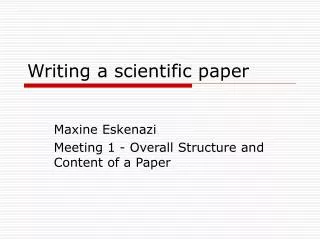
Writing a scientific paper
Writing a scientific paper. Maxine Eskenazi Meeting 1 - Overall Structure and Content of a Paper. IMPORTANT NOTE. We will talk about conference papers, not journal papers WE WILL USE PUBLISHED PAPERS IN THIS COURSE AS EXAMPLES NEVER NEVER NEVER COPY THE CONTENTS OF A PUBLISHED PAPER
398 views • 14 slides

Writing a scientific paper. Khon Kaen 2555. If you want to learn sailing. Start to love the Sea. If you want to learn writing. Start to love nice stories. The most important problem in scientific writing is given by the formula : E = mc 2. E = mc 2.
586 views • 50 slides
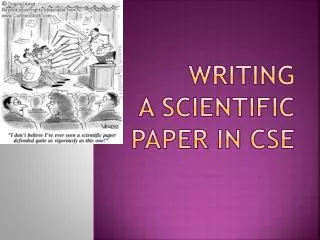
Writing a scientific paper in CSE
Writing a scientific paper in CSE. Writing style. Exemplary scientific writing is: Accurate Clear Concise (Writing…1996). 1. Plan. Develop a rough outline or a table of contents. It’ll provide you a sense of direction (Writing…1996). 2. Use Formal english (Writing…1996).
658 views • 33 slides

Writing a scientific research paper. ESPOL Dr. Jan Feyen 30 March 2012. Content. 1. Paper format. Title Authors, affiliation ABSTRACT INTRODUCTION MATERIALS AND METHODS RESULTS AND DISCUSSION CONCLUSIONS Acknowledgements References. Title Authors, affiliation ABSTRACT
1.04k views • 71 slides
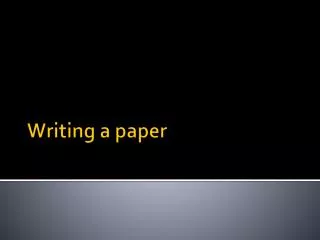
Writing a paper
Writing a paper. Organization. Logical overall organization (e.g., international comparisons, broad US trends, subgroup trends, causal relationships ( scattergrams ). Paragraph organization paragraph addresses one main topic, each topic is fully developed Topic sentence. Concise Writing.
269 views • 11 slides

An Introduction to Writing a Scientific Paper
An Introduction to Writing a Scientific Paper. Doug Welch McMaster University Citizen Sky Workshop Sep 2010. Properties of a Good Paper. Informative title Informative abstract Reports a finding (or findings) Provides context and motivation for work reported Explains data used
339 views • 17 slides
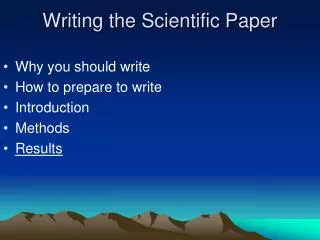
Writing the Scientific Paper
Writing the Scientific Paper. Why you should write How to prepare to write Introduction Methods Results. Purpose of Results Section. “To give as clear an answer to the question to be answered by the research as your data will permit” —Ed Huth. Goals of Results Section.
753 views • 25 slides
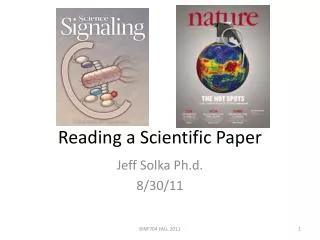
Reading a Scientific Paper
Reading a Scientific Paper. Jeff Solka Ph.d . 8/30/11. Acknowledgements. Portions of this slide deck were adopted from the following slides www.bio.unc.edu/faculty/Khogan/ HowToReadAScientificPaper . ppt. Caveats of This Lecture.
336 views • 23 slides

Writing a Paper
Writing a Paper. Michalis Faloutsos. Publishing a paper. Having a good idea is not enough You need good and clear writing You need to make clear claims Work needs to be bullet-proof. Typical Conceptual Problems. Missing previous work: deadly Not compare with “ competition ”
266 views • 17 slides
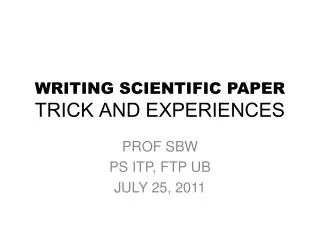
WRITING SCIENTIFIC PAPER TRICK AND EXPERIENCES
WRITING SCIENTIFIC PAPER TRICK AND EXPERIENCES. PROF SBW PS ITP, FTP UB JULY 25, 2011. TRICKS & EXPERIANCES. KNOW THE JOURNAL KNOW CHIEF EDITOR, HAVE LONG AND CLOSE RELATIONSHIP (IN SCIENCE & KNOWLEDGE) WITH THE CHIEF EDITOR OR VIP/MEMBERS OF EDITORS
229 views • 6 slides

Writing a Scientific Paper. There are two reasons why you should learn how to write good reports of your science projects. by putting your work into words, you will gain a better understanding of your project.
519 views • 29 slides

Writing a scientific paper. Lammert Kooistra & Joep Crompvoets Contact: [email protected]. RS&GIS Integration Course (GRS-30806). Contents. Paper Assignment Structure of scientific paper Guidelines and format Writing style Assessment criteria Group work vs. individual paper.
532 views • 13 slides

Scientific Methodology and Scientific Paper Writing
Scientific Methodology and Scientific Paper Writing. The Department of Ecology & Evolutionary Biology, Fudan University Bao-Rong Lu. 复旦大学 卢宝荣. 主要社会兼职 : 国际生物安全研究学会( ISBR )主席,中国国家生物安全委员会委员,中国植物学会理事,中国生物技术学会理事 担任编辑 :
1.24k views • 74 slides
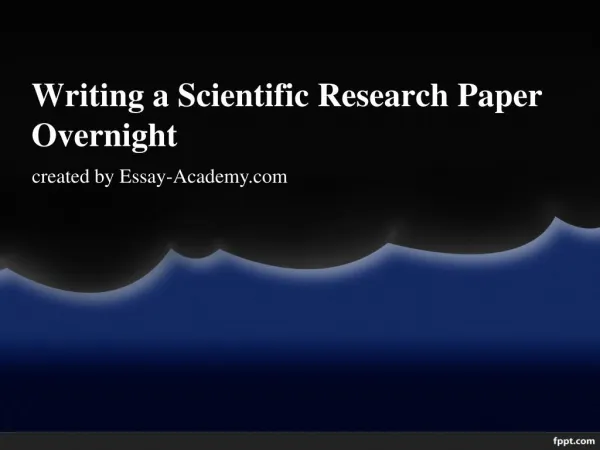
Writing a Scientific Research Paper Overnight
If you are to write a scientific research paper overnight, you should know some important tips. Find them in this presentation!
257 views • 7 slides
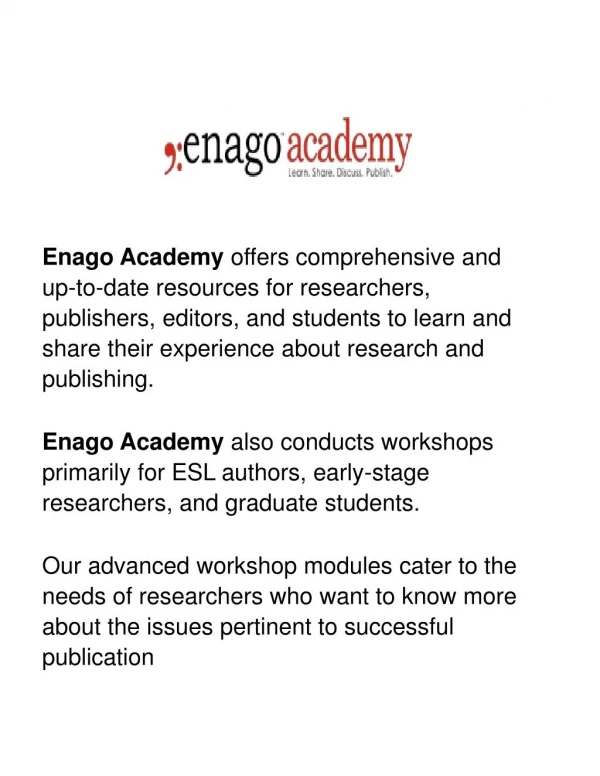
Writing Your First Scientific Research Paper
This article gives tips while Writing Your First Scientific Research Paper
662 views • 8 slides

HOW to Writing a scientific paper
Presentation about 'HOW to Writing a scientific paper'
7 views • 0 slides

205 views • 17 slides

Essential Things for Writing a Scientific Research Paper
Check out the essential things for writing a scientific research paper. Looking for a research paper writing service? Visit https://www.cheapestessay.com/research-paper-writing-services now!
89 views • 7 slides

IMAGES
VIDEO
COMMENTS
7. Structure of the Research Paper Section Purpose of the Section Methodology To demonstrate that you are aware of the research methods used to study this topic. To explain and justify the method of data collection and analysis. Results To present the findings of your research in an orderly manner, using heading planned in your methodology or headings arising from patterns found in the research.
Creating a PowerPoint presentation for a research paper involves several critical steps needed to convey your findings and engage your audience effectively, and these steps are as follows: Step 1. Understand your audience: Identify the audience for your presentation. Tailor your content and level of detail to match the audience's background ...
Here are some simple tips for creating an effective PowerPoint Presentation. Less is more: You want to give enough information to make your audience want to read your paper. So include details, but not too many, and avoid too many formulas and technical jargon. Clean and professional: Avoid excessive colors, distracting backgrounds, font ...
Turning a research paper into a visual presentation is difficult; there are pitfalls, and navigating the path to a brief, informative presentation takes time and practice. As a TA for GEO/WRI 201: Methods in Data Analysis & Scientific Writing this past fall, I saw how this process works from an instructor's standpoint.
HOW TO WRITE AN EFFECTIVE RESEARCH PAPER. Getting ready with data. First draft. Structure of a scientific paper. Selecting a journal. Submission. Revision and galley proof. Disclaimer: The suggestions and remarks in this presentation are based on personal research experience. Research practices and approaches vary.
Related Articles. This guide provides a 4-step process for making a good scientific presentation: outlining the scientific narrative, preparing slide outlines, constructing slides, and practicing the talk. We give advice on how to make effective slides, including tips for text, graphics, and equations, and how to use rehearsals of your talk to ...
In the case of a research presentation, you want a formal and academic-sounding one. It should include: The full title of the report. The date of the report. The name of the researchers or department in charge of the report. The name of the organization for which the presentation is intended.
Visualize Data Instead of Writing Them. When adding facts and figures to your research presentation, harness the power of data visualization. Add interactive charts and graphs to take out most of the text. Text with visuals causes a faster and stronger reaction than words alone, making your presentation more memorable.
This talk offers seven simple, concrete suggestions for how to improve your research papers. You may also find my talks on how to write a great research proposal and how to give a great research talk useful. Powerpoint slides of the talk: PDF PPT (you should feel free to repurpose these slides for your own use as long as you acknowledge ...
A good oral presentation is focused, concise, and interesting in order to trigger a discussion. Be well prepared; write a detailed outline. Introduce the subject. Talk about the sources and the method. Indicate if there are conflicting views about the subject (conflicting views trigger discussion). Make a statement about your new results (if ...
Choose a research paper topic. Conduct preliminary research. Develop a thesis statement. Create a research paper outline. Write a first draft of the research paper. Write the introduction. Write a compelling body of text. Write the conclusion. The second draft.
Published on October 8, 2021 by Tegan George and Julia Merkus. Revised on July 23, 2023. We have adapted several of our most popular articles into lecture slides that you can use to teach your students about a variety of academic topics. Scribbr slides are free to use, customize, and distribute for educational purposes.
Tips for Research Paper Presentations. There should be 5*5 rules in each slide. I.e. there are five words in one sentence and there should be five lines on one slide. Data should be in the form of small key points or bullets. Data should not be in paragraph form on the slide. It should be precise.
3 or 4 data sets per figure; well-selected scales; appropriate axis label size; symbols clear to read; data sets easily distinguishable. Each photograph must have a scale marker of professional quality in a corner. Use color ONLY when necessary. Color must be visible and distinguishable when printed in black & white.
Then research paper is written by referring to outlines, notes, articles, journals and books. The research paper should be well structured containing core parts like introduction, material and methods, results and disscussion and important additional parts like title, abstract, references. Download Free PDF.
Writing and Publishing a Research Paper. Oct 16, 2015 • Download as PPT, PDF •. 33 likes • 17,816 views. Padmanabhan Krishnan. This ppt illustrates the art of writing and publishing research papers, its demands and impact. Education. 1 of 49. Download now. Writing and Publishing a Research Paper - Download as a PDF or view online for free.
Writing papers: model 2 Idea Do research Write paper Idea Write paper Do research ! Forces us to be clear, focused ! Crystallises what we don't understand ! Opens the way to dialogue with others: reality check, critique, and collaboration s a ing ch rting t)
The research paper can be considered as the living thing which grows and changes as the student explores, interprets and evaluates sources related to a specific topic. Steps to write a research paper: • Choose your topic. • Begin your search. • Making an outline. • Write your paper.
The Research Paper Presentation Template starts with a title slide displaying the topic of the research presentation. Next, there is an agenda slide and a slide showing the examination's background. In the problem statement slide, presenters can display the scope of the study, its relevance, and the associated research questions.
Step 5: Click "Generate Presentation". After uploading your research paper, click on the "Generate Presentation" button. Let MagicSlides work its magic, transforming your academic research into a visually appealing PowerPoint presentation.
Project Research Infographics. Download the "Project Research Infographics" template for PowerPoint or Google Slides and discover the power of infographics. An infographic resource gives you the ability to showcase your content in a more visual way, which will make it easier for your audience to understand your topic.
Writing a Scientific Paper. Writing a Scientific Paper. Dr. Shaik Shaffi Ahamed Ph.D ., Assistant Professor Department of Family & Community Medicine College of Medicine King Saud University. What is a Scientific Paper ?. A scientific paper is a written and published report describing original research results.
2. IMRAD IMRAD is an acronym that stands for the common sections of a scientific research or lab report. Introduction Method Results [And] Discussion. 3. Where did it come from? In 2004, the Journal of the Medical Library Association published an historical study on the origins of the format, and found that although the first instance of the ...